Tag: Primer Tips
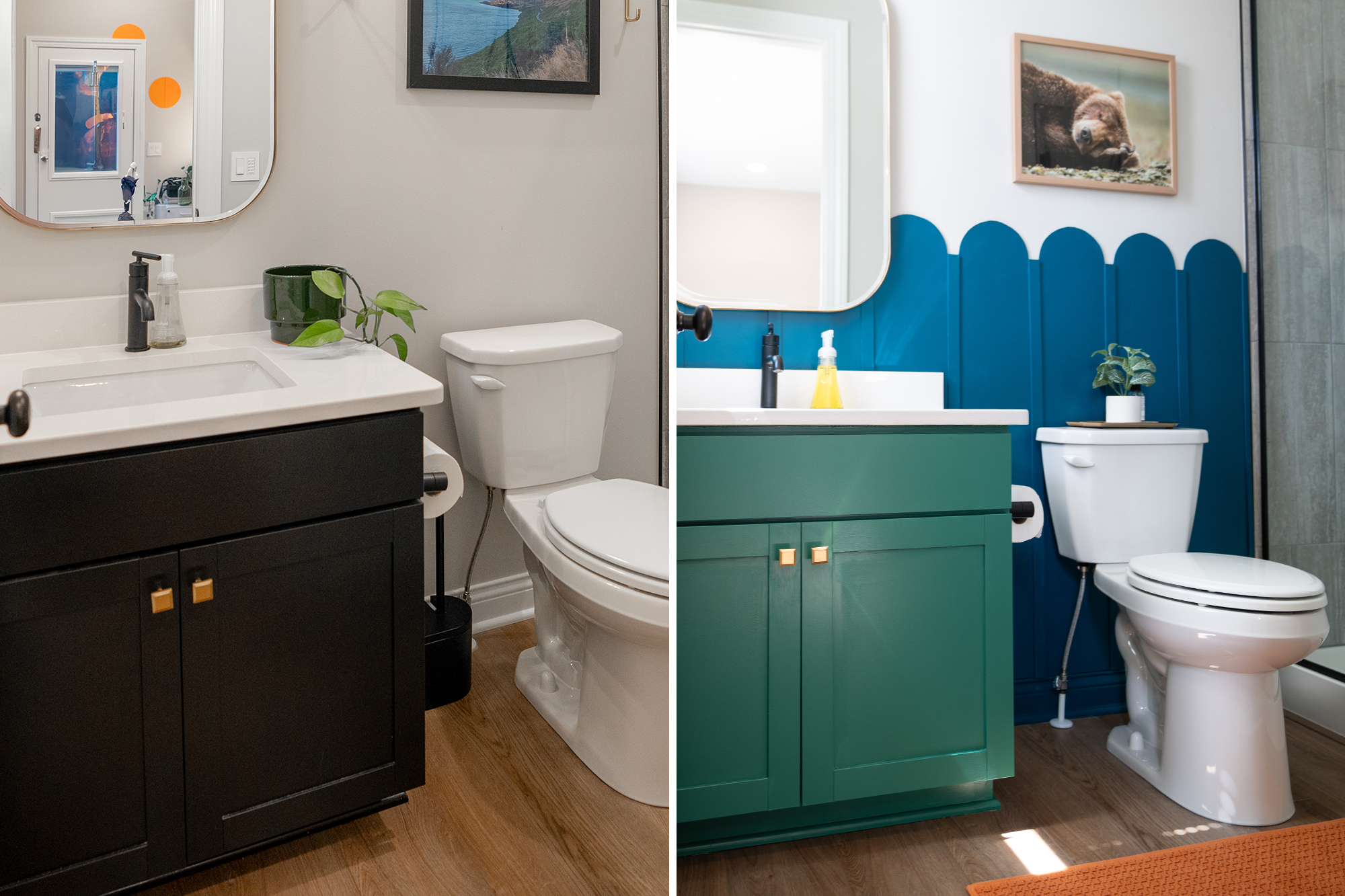
Project Spotlight: A Bright Bathroom Refresh
June 25, 2024Who We Are and How We Arrived Here

Hi, we’re David and Edward Guerra, also known as Midwest Husbands! We met in Madison, Wisconsin where we taught ourselves a lot of DIY skills by flipping a property. We then moved to Cleveland, Ohio where we enjoyed a well-lived in home before our custom build, where we hope to raise a family one day soon. We also seek travel adventures and bring the inspiration from the experiences into our home through unique design choices.
We designed and built our current house less than two years ago, yet here we are, already wanting to change the color of a cabinet in one of our bathrooms! Decision fatigue during the home-building process is real. Initially, we thought a dark-stained vanity would be beautiful for a second primary suite bathroom on the first floor of our New England-style colonial. However, this cabinet was too dark, and we thought it would be fun to incorporate more life and color into this space since it serves as the bathroom connected to what is currently used as a work-from-home office. To change from a dark cabinet to any other color, priming with a premium high-hiding primer is the first step to get the best results.
For other crafted wood pieces in our home and pre-wallpaper, we have used KILZ 2® All-Purpose Primer in previous years. Since this bathroom project involved a starting point of a dark color on the cabinets, we turned to KILZ 3® Premium Primer for its high hide formula and mildew resistant coating, which was perfect for our dark bathroom cabinet.
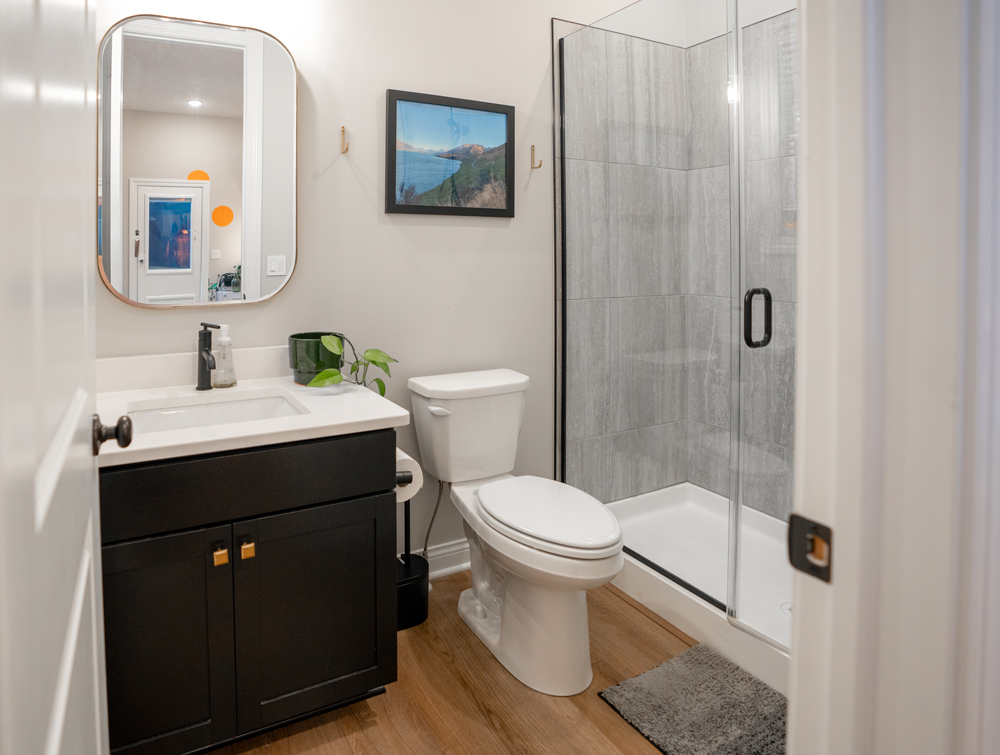
Inspiration and Implementation
After consulting a few of our favorite magazines, we created a palette with the incredible colors in Magnolia Home by Joanna Gaines® collections. Then, we were off to our local Ace Hardware store to pick up the paint, supplies, and, of course, the KILZ 3® Premium Primer for this bathroom glow-up.
KILZ 3® Premium Primer was incredible to use on the cabinet doors. It’s fast drying (which makes it ideal for a weekend project), has low odor, and is very low VOCs. It has exceptional adhesion to a wide variety of surfaces which will help ensure the paint finish lasts for years to come, plus it’s water-based which makes clean-up a breeze. We liked how it worked for the glossy finish on the doors, and we also used this primer on the arch panels and molding we created for the feature wall.
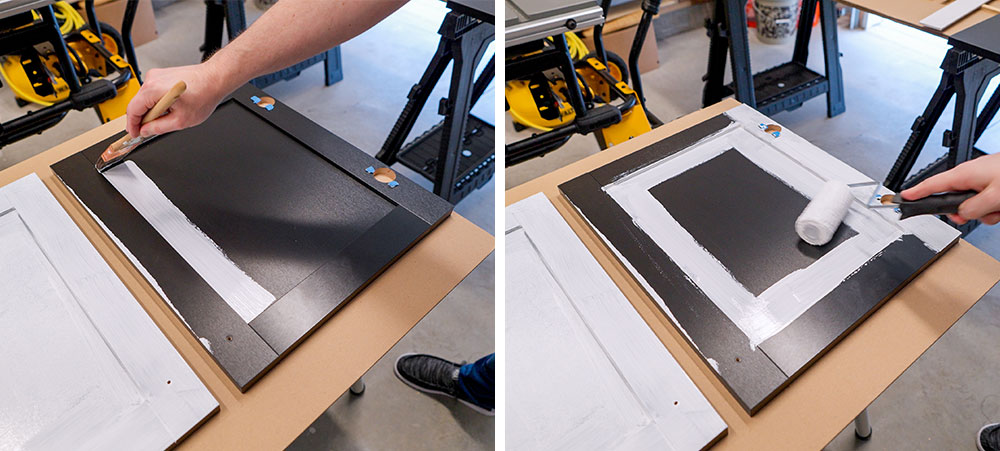
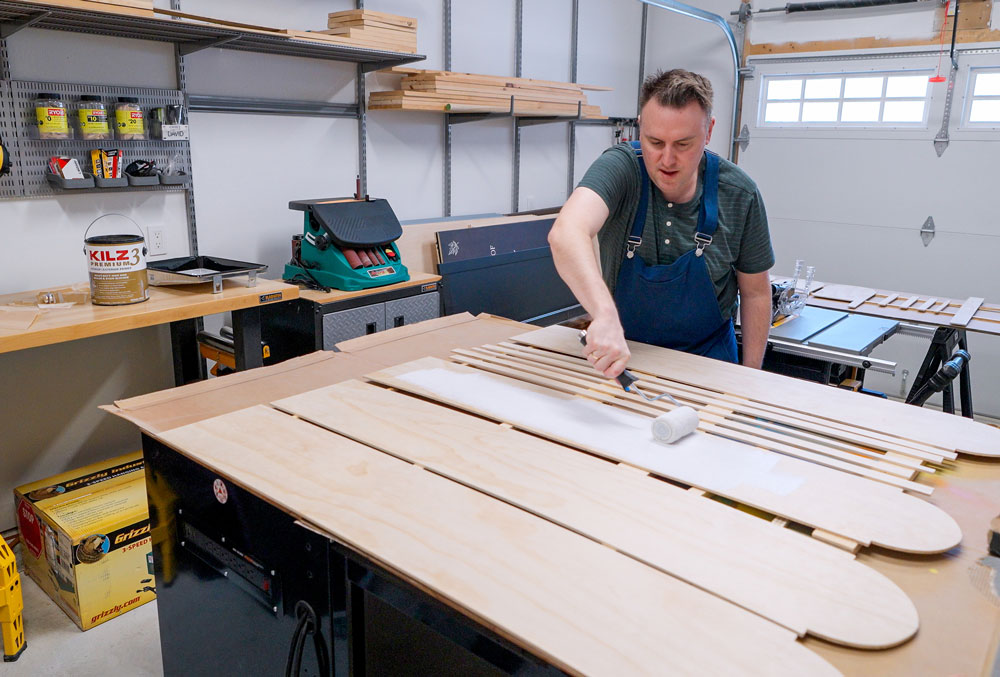
It’s important to not jump into painting cabinets or wood without a quality primer. This step saves time and money because, without a primer, you will likely end up applying more coats of your paint, which ends up costing more than primer.
Within an hour, we were painting the first of two coats of paint on the cabinet doors, the paneling, and trim pieces. The paint color we used was Under The Stars, a deep teal-blue color that evokes a seaside feel. The cabinet contrasts with Aspen Leaf, a green that brings refreshment and peace into the space. Since the paneling is just over 4′ tall, Yarn completes the look by rising to the ceiling with crisp and inviting tones.
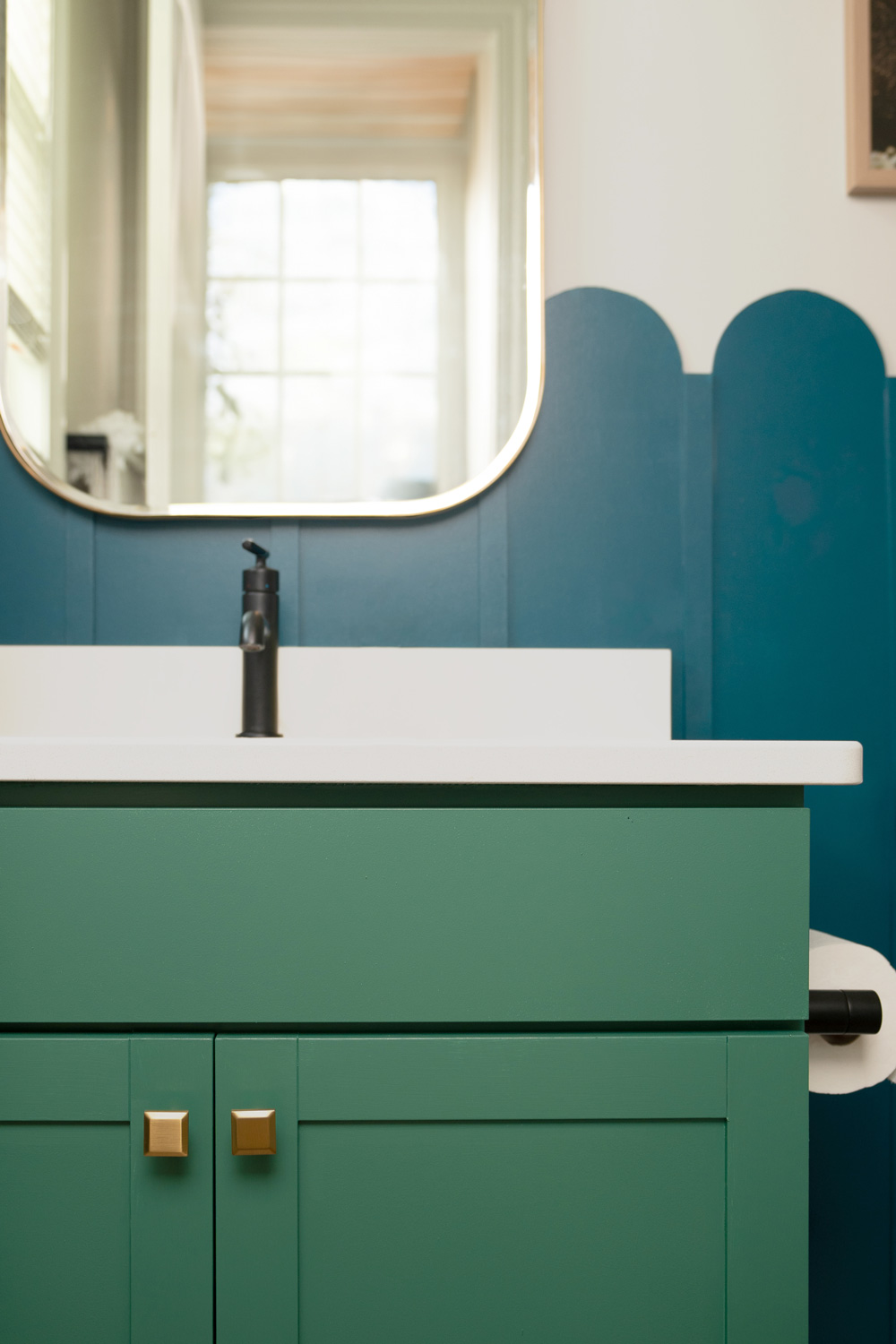
Putting Fun in Functionality
Knowing that we used KILZ 3® Premium Primer as a surface prep measure in our project gives us confidence that the cabinet, paneling, and trim will look good for years to come. We are so excited to have taken a dark-stained, glossy sheen built-in vanity to a new level of life. KILZ 3® hides dark and bold colors as well as blocks stains therefore creating a clean slate for lighter color conversions ensuring better results!
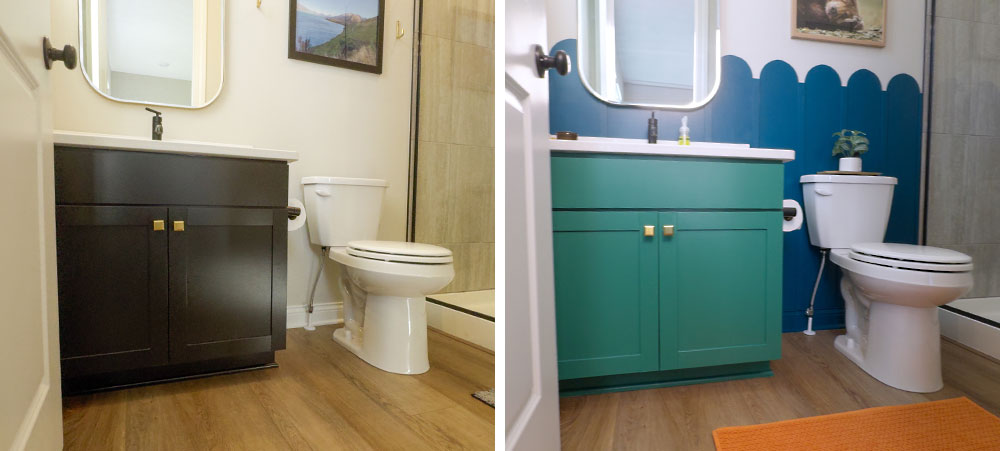
Previously, the door to the bathroom was often closed during the workday while on video conference calls. But now, keeping the door open with the pops of color achieved with Magnolia Home by Joanna Gaines® Paint is quite a boost for our environment. Walking into the bathroom welcomes us, and we must admit that despite being in a small space, we don’t want to leave!
We needed to keep this cabinet in the bathroom as it provides storage for all the essentials and toiletries. Thanks to the amazing products KILZ offers, we were able to take this space from builder-grade to a degree of personalization that matches up to what we love to do.
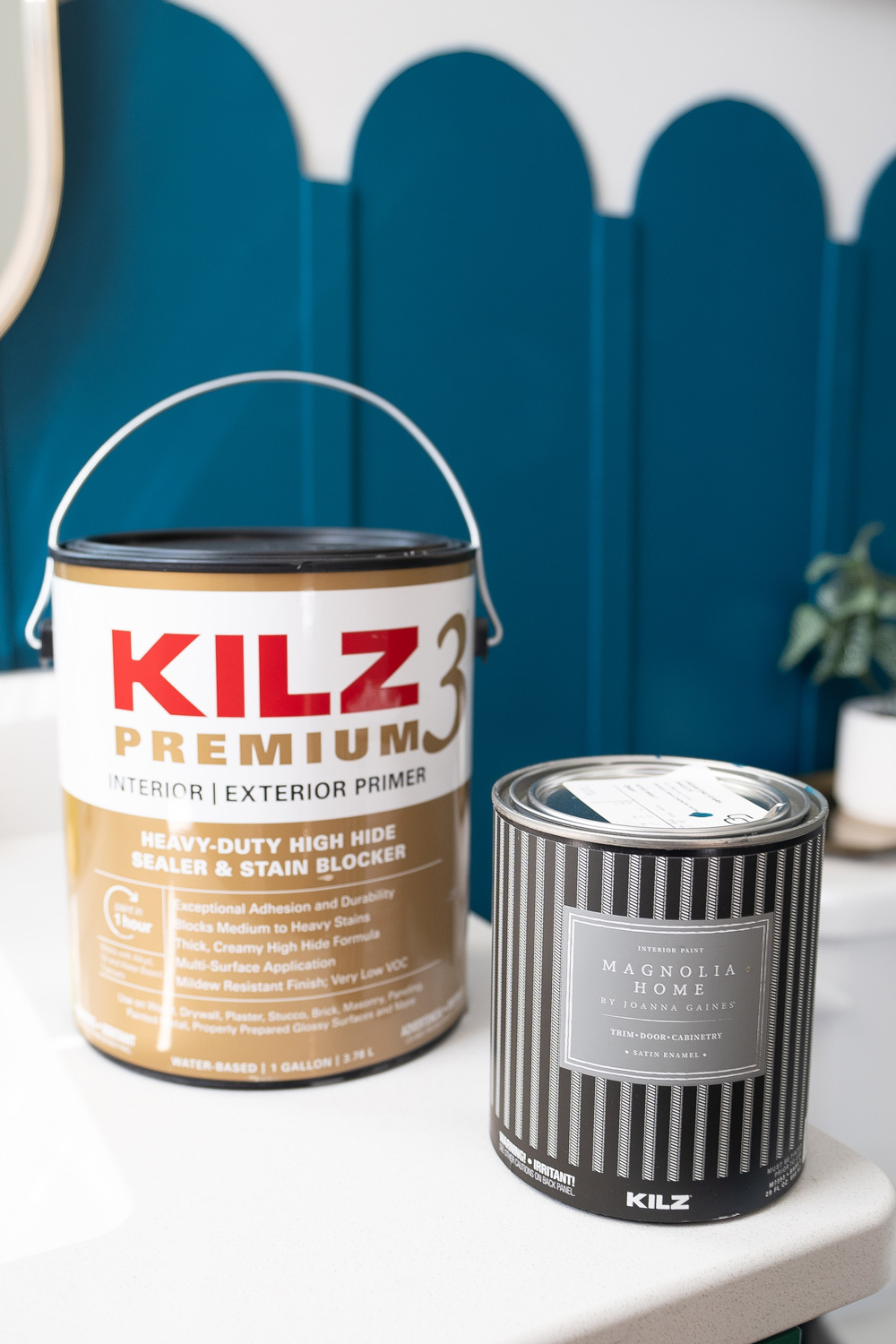
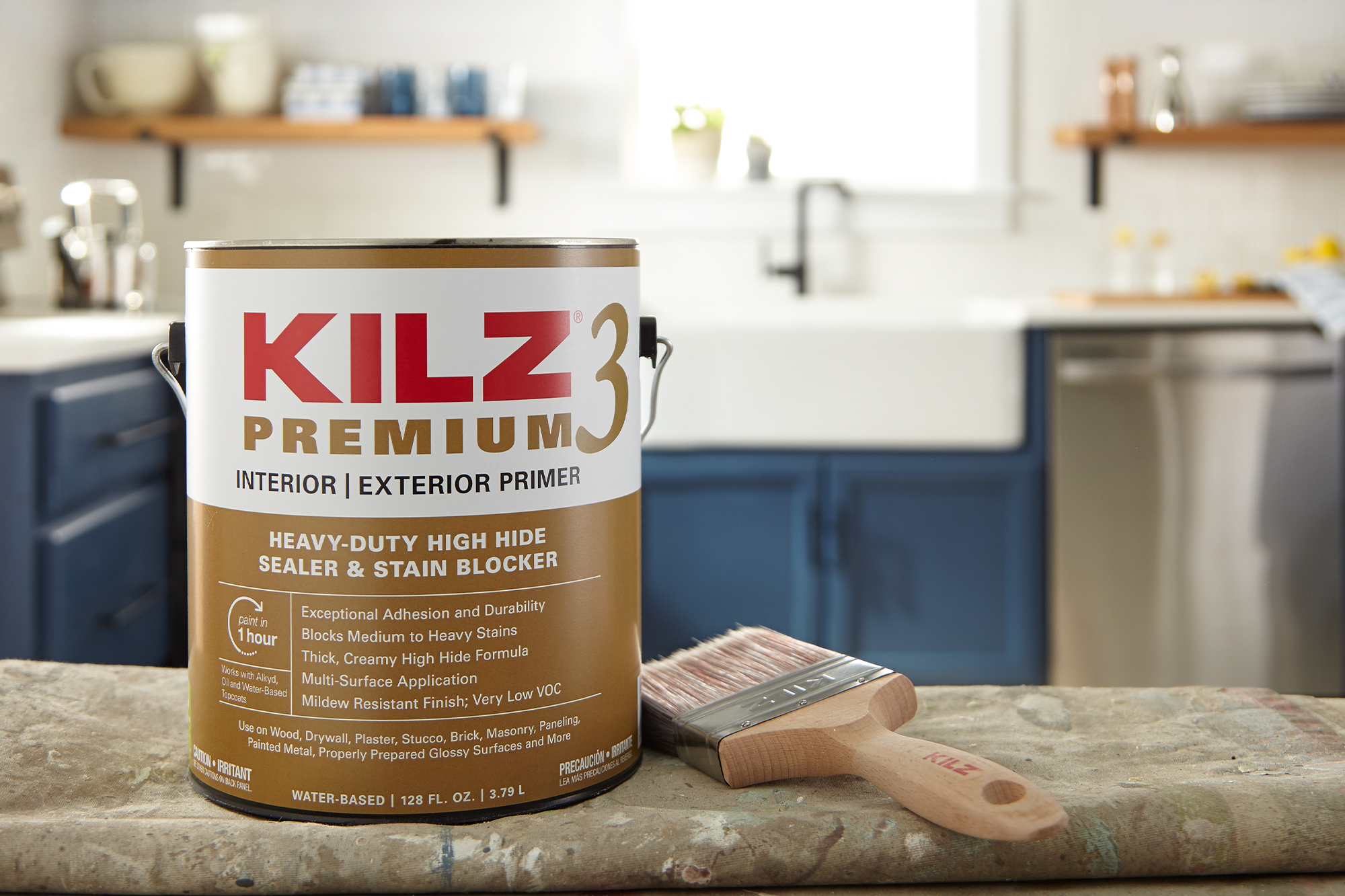
The Primer Checklist Every DIYer Needs
April 23, 2024Priming Before You Paint
No matter how difficult your project is, KILZ® Primer is here to help you achieve the results you envision with this easy primer checklist.
Priming walls before applying a coat of paint is essential to block previous stains and odors, ensure color distribution, and create adhesion for the new coat of paint.
Primer Checklist
First, familiarize yourself with the surfaces and spaces you’ll be painting. Whether you’re priming outdoor or indoor, on wood, glass, metal, or drywall, each scenario requires a specific primer and process.
Choose the Right KILZ® Primer
Getting started requires you to understand which KILZ® Primer is the right product for your surface’s unique demands.
• Both KILZ 2® All Purpose and KILZ 3® Premium are perfect for interior and exterior priming on multiple surfaces. KILZ 3® Premium is the right primer for heavy duty sealing and blocking out stains or dark colors.
• KILZ RESTORATION® is formulated for the toughest coverups, like fire damage or unbearable odors.
• If you’re applying a new coat of paint in a kitchen or bathroom, mold and mildew resistance should be prioritized with KILZ® Mold and Mildew®.
• For tough-to-paint surfaces like glass, tile, and metal, KILZ® Adhesion ensures that paint stays put.
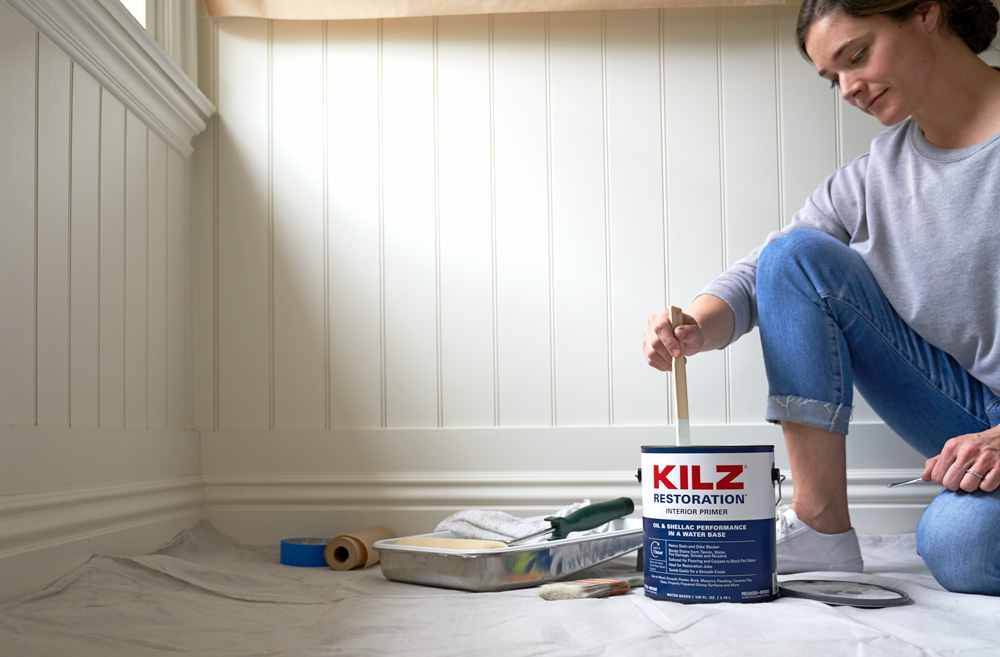
Application Tools
The tools required to prime walls to paint are:
• A drop cloth to protect floors from splatter.
• Painter’s tape for masking off areas you don’t want primer on.
• A 2-inch nylon/polyester paint brush for priming corners.
• A 9-inch paint roller with a ½ inch roller cover to prime large spaces.
• A paint tray to reload your roller with primer you pour into the tray.
• Cardboard or a towel to remove excess primer from your roller or brushes.
• Safety goggles to protect your eyes.
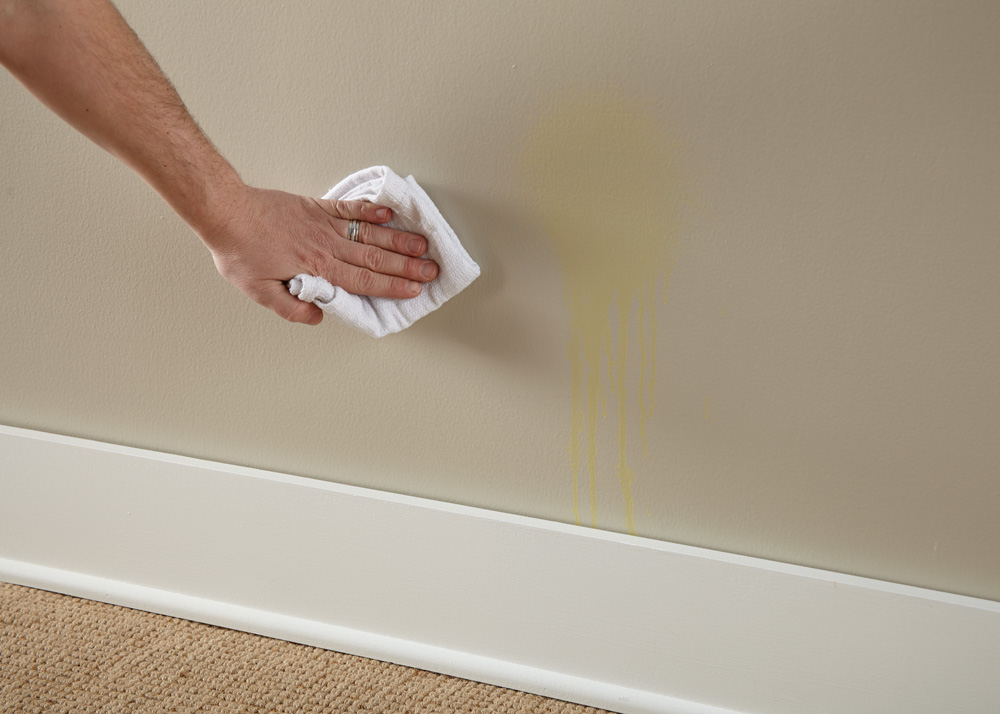
Applying the Primer
• Move any furniture from the space, then cover the floor with your drop cloth.
• Create a paint station to place all your tools.
• Tape off the necessary borders to mask whatever you don’t want your primer to cover.
• Get your paint roller and brushes ready by dampening them with water so they can absorb more primer.
• Outline or “cut in” the wall with 2-3 inches of primer. Where the corners meet, you’ll want to use your 2-inch nylon/polyester paintbrush.
• Fill your paint tray with primer, then dip in your 9-inch paint roller, making sure primer covers the whole roller. Pass the paint roller over the ridged area of the tray to remove any excess primer.
• With your paint roller, apply the primer in vertical strips inside your “cut in” area, working from top to bottom until finished.

Dry Time
Drying times depend on both your primer and surface. If multiple layers are needed, wait until the primer is completely dry before applying another coat. You can decrease drying time by creating air circulation in the room or using a dehumidifier.
• Drywall (about an hour)
• Wood (up to three hours)
• Metal (up to four hours)
Never apply paint before your primer has dried; otherwise, it will not stick, creating a mess.
You’re Ready to Prime
Now that you have an understanding of KILZ® Primers, you can undertake your next project, whether you are an amateur or expert DIYer.
→DOWNLOAD CHECKLIST
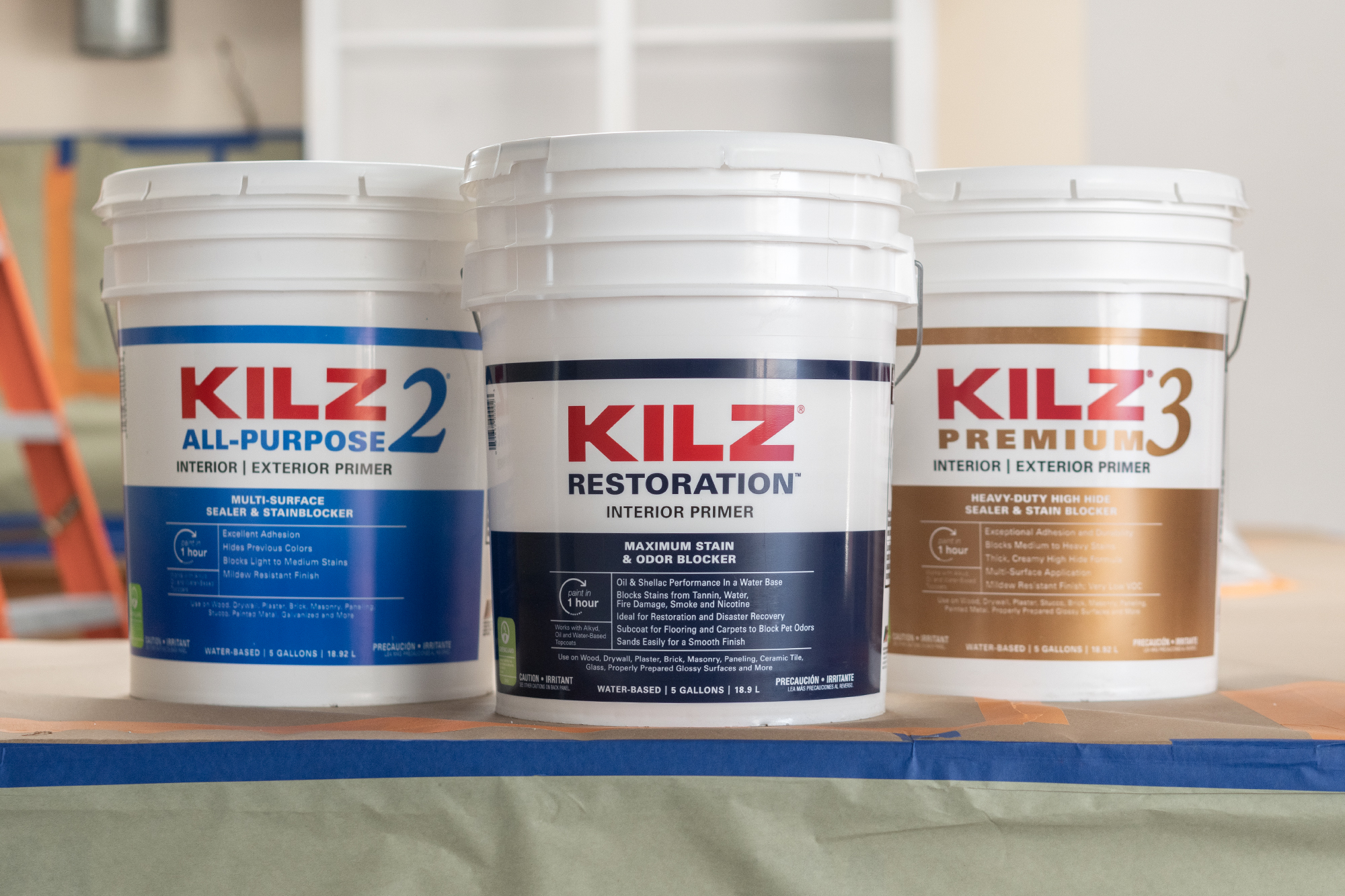
DIY Made Easy with KILZ® Primer
April 2, 2024Getting started
DIY’ers know that when it comes to home restoration and remodeling, shortcuts can’t be taken. Perfect painting requires the perfect primer to solve the multitude of problems that any surface presents. Ensuring you have the right foundation with a quality primer like KILZ® can set you up for success. This guide simplifies the selection process for primers that best fits your project and outlines the essential tools for application.
Why Prime?
Primer ensures your paint adheres to the surface properly, making it last longer. It achieves even color and full coverage with fewer coats, prevents old stains and colors from bleeding through, and adds a protective layer, which is vital for exterior projects.
The first step in any project is making a Painting Checklist of all the tasks you’ll need to take on. Know your surfaces and space. Whether you’re priming to paint outdoors or indoors, on wood, glass, metal or drywall, each scenario requires a specialized primer and process.

Choosing the Right KILZ® Primer
KILZ 2® All Purpose
• Ideal For: Indoor/outdoor use.
• Highlights: Fast drying, water-based, multi-surface primer-sealer-stain blocker with excellent adhesion and mildew resistance.
KILZ 3® Premium
• Ideal For: Versatile indoor/outdoor use on wood, plaster, concrete, etc.
• Highlights: High-hiding formula is great for color change and blocking medium to heavy stains.
KILZ Restoration®
• Ideal For: Addressing heavy-duty stains like smoke or water damage.
• Highlights: Combines oil-based primer benefits with water-based formula ease.
KILZ® Adhesion
• Ideal For: Difficult surfaces like glossy finishes, PVC, or metal.
• Highlights: Enhances paint adhesion where traditional primers fail.
KILZ® Mold & Mildew
• Ideal For: Moisture-prone and high-humidity environments such as kitchens, bathrooms, and laundry rooms.
• Highlights: A stain-blocking primer that resists mold and mildew growth on the primer film.
Required Tools And Preparation
Preparing your surface is an important step before applying primer, never prime over a dirty surface, clean your surface as best you can before you apply primer.
Here’s what you’ll need for primer application:
• Brushes: High-quality brushes are essential for cutting in around edges and in tight spaces. A 2-3 inch angled brush is versatile for most projects.
• Rollers: For larger surfaces, a roller can make the application quicker and more efficient. Use a roller with the appropriate nap length for your surface; smoother surfaces require a shorter nap.
• Paint Tray: Essential for holding primer and rolling out excess before application.
• Sandpaper: After the primer dries, you might need fine-grit sandpaper (around 220 grit) for smoothing out any bumps or imperfections.
• Drop Cloths: Protect your floors and furniture from drips and spills.
• Painter’s Tape: Use this to mask off areas you don’t want primed, such as trim or windows.

Applying Primer
Follow these 4 steps for proper primer application:
1. Surface Prep: Clean and sand your surface as needed to ensure it is smooth and ready for primer.
2. Apply Primer: With your chosen tools, apply the primer in even, controlled strokes or rolls, following the specific directions for your Kilz product.
3. Inspect and Sand: After drying, check for drips or rough spots, sanding lightly if necessary.
4. Paint Application: Once the primer is dry, proceed with painting, enjoying the smooth base your primer has created.
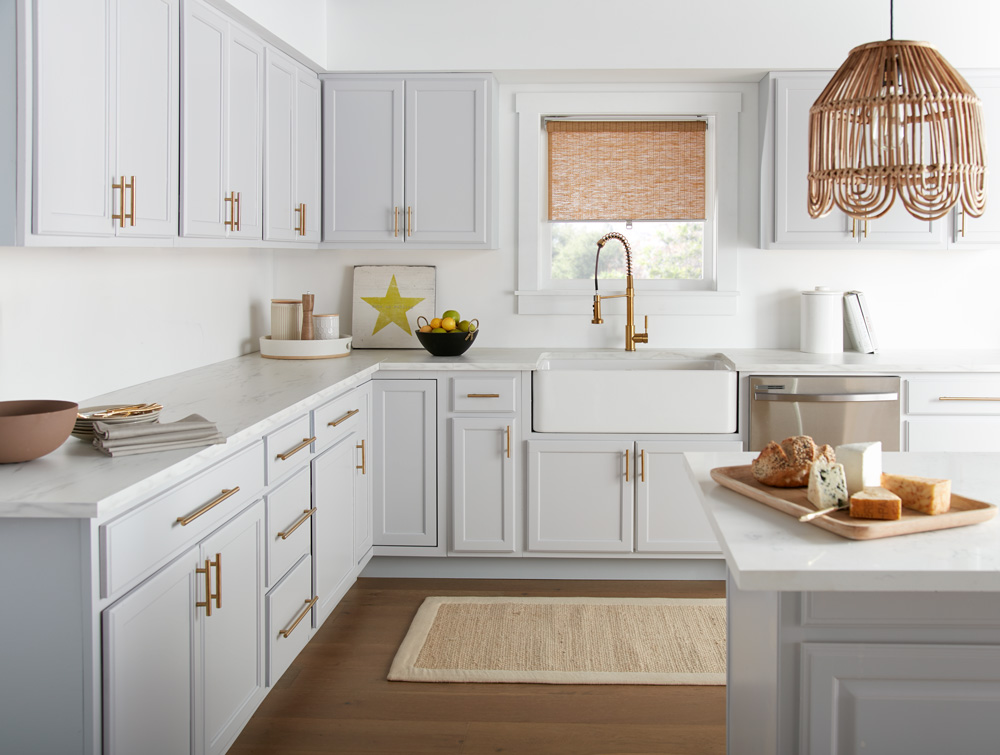
Your Surface Is Now Ready For Paint
Selecting the right KILZ® primer and using the proper tools for application can dramatically affect the quality and longevity of your project. Whether tackling a small piece of furniture or an entire room, starting with a solid foundation will ensure a professional-looking finish that lasts. Dive into your project with confidence, knowing you’re equipped with the best products and tools for the job.
Happy DIYing!
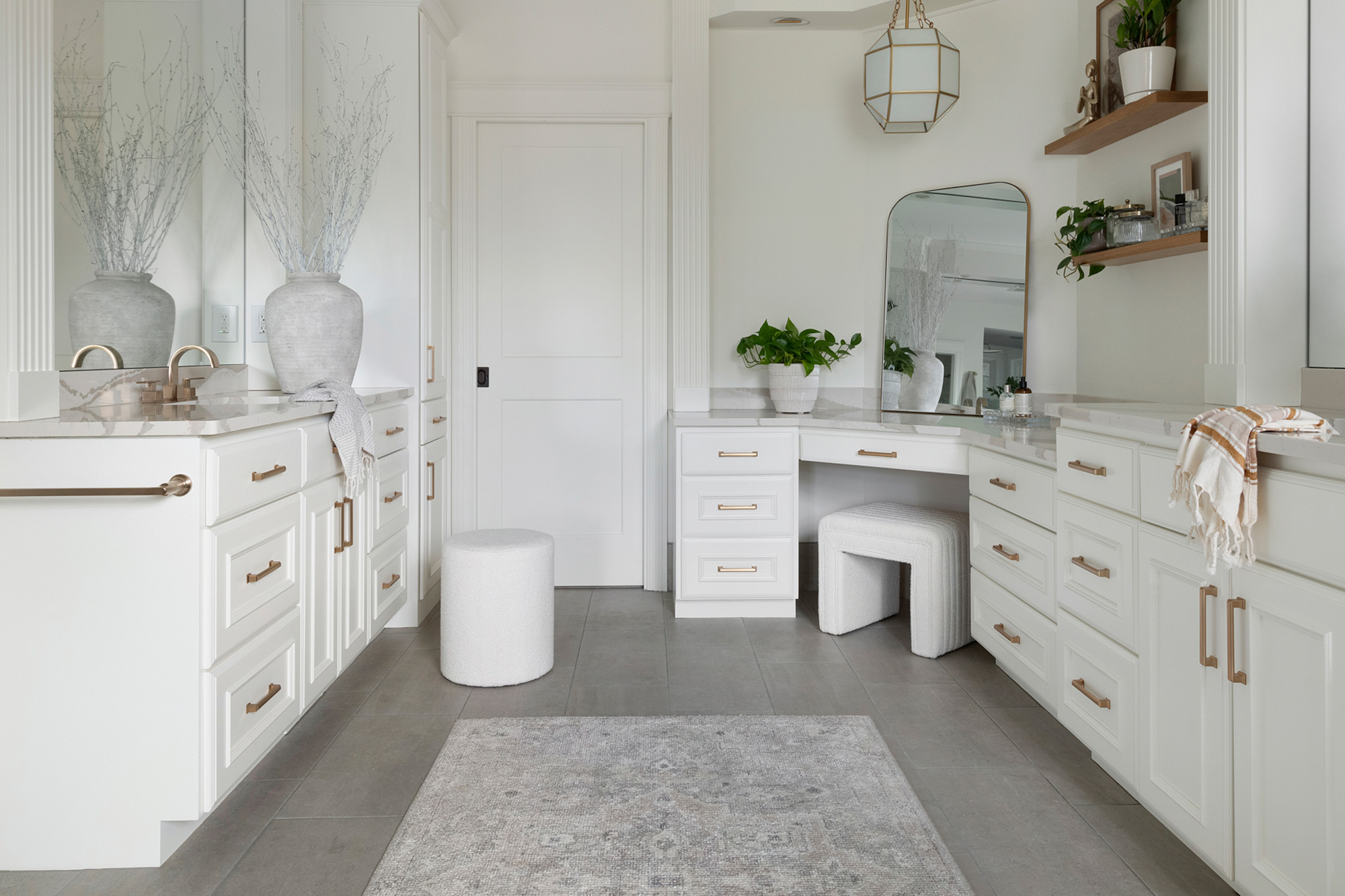
PROJECT SPOTLIGHT: A BATHROOM REMODEL WITH KILZ® PRIMERS – PART 2
January 3, 2024Welcome back to part 2 of the bathroom remodel project from Jamie and Morgan Molitor of c2s. We’re excited to share the reveal and complete transformation of this primary bathroom project. As you may recall from the first blog post, this project was one of the c2s team’s latest ventures for whom we have the privilege to call a mentor and friend, the wonderful Chris Freytag. A prominent health and fitness influencer, blogger, author, and esteemed figure in the Twin Cities and nationally.
A bathroom remodel transcends the mere act of updating a space; it’s about curating a sanctuary that exceeds ordinary functionality. Your primary bathroom space is a place where your day both begins and ends. You set your intentions for the day in the space and reflect in the evening. Let’s dive into the details of this breathtaking makeover!
This bathroom remodel entailed a complete overhaul, minus the existing cabinetry. Beyond that, it was a gut-and-remodel project that blended transitional tradition with contemporary elegance. Far beyond mere aesthetics, this transformation dove deep into the realm of luxurious tranquility, converting an outdated bathroom into a serene oasis of relaxation.
BEFORE
Chris and her husband were intent on crafting a bathroom that exuded a light and airy ambiance. Their vision revolved around a palette dominated by bright whites, seeking to replace the subdued beige hues. They aimed for a space that felt refreshed, spacious, and radiant. This desire for a luminous atmosphere prompted a comprehensive renovation, encompassing various elements such as paint, countertops, tiles, and fixtures. Their strategic choice to embrace these lighter tones played a pivotal role in transforming the bathroom into an inviting and open environment.
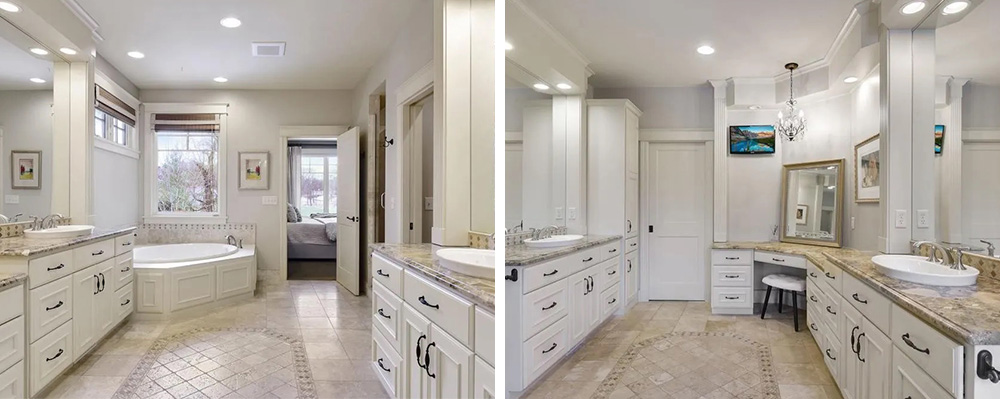
AFTER
Out with the old and in with the new – the freestanding tub isn’t just an aesthetic choice; it’s a practical one. The liberation of space not only visually opens up the bathroom but also offers a tangible sense of freedom. A spa-like experience is rooted in space and serenity, and the freestanding tub became the embodiment of both. And with our client’s visible love for plants – we knew that this space called for many plant friends to surround it.
A spa-like bathroom isn’t complete without an indulgent shower experience. We enlarged the shower door opening, not just for practicality, but to help create an oasis of relaxation. The white subway tiles and quartz bench are not just design choices; they are elements that enhance the spa-like ambiance, inviting you to linger and rejuvenate.

DESIGN DETAILS
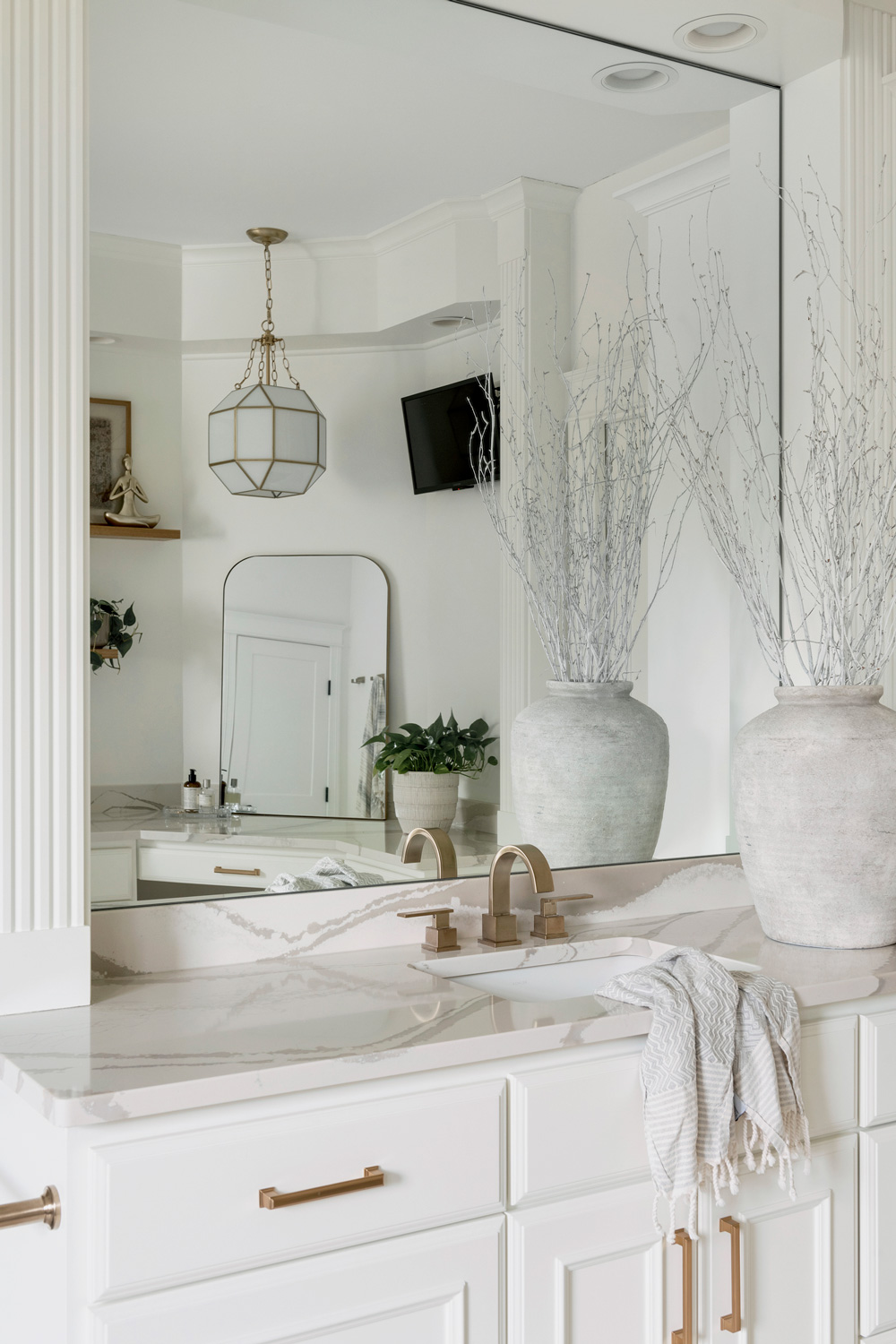 Our client expressed a desire for a retreat-like feel after long, hectic days. At c2s, we recognize that a spa-inspired bathroom transcends a passing trend; it’s an investment in personal well-being. The remodel’s embodiment of modern elegance fosters an atmosphere of serenity. Through the addition of a freestanding tub boasting clean lines, the space invites you to decompress, becoming a focal point that reshapes the bathroom into a private sanctuary. The integration of contemporary elements with the existing cabinetry achieves a harmonious fusion, ensuring relaxation without sacrificing style.
Our client expressed a desire for a retreat-like feel after long, hectic days. At c2s, we recognize that a spa-inspired bathroom transcends a passing trend; it’s an investment in personal well-being. The remodel’s embodiment of modern elegance fosters an atmosphere of serenity. Through the addition of a freestanding tub boasting clean lines, the space invites you to decompress, becoming a focal point that reshapes the bathroom into a private sanctuary. The integration of contemporary elements with the existing cabinetry achieves a harmonious fusion, ensuring relaxation without sacrificing style.
Enhancing the serene, light, and airy ambiance of a spa-like bathroom involves thoughtful choices that marry elegance with functionality. For instance, the selection of Cambria quartz countertops was more than just a design decision; it was a tactile experience that elevated the space’s luxuriousness. The warm veining not only unified the bathroom’s aesthetic but also offered a touch of opulence to the daily routine. This investment in quality materials brought forth an everyday sense of luxury, emphasizing both comfort and visual appeal.
PRIMER
Investing in primer isn’t merely about enhancing the final look; it’s about creating a blank canvas so that a space can transform into a tranquil oasis. KILZ® Primers were the unsung hero of the project that provided consistent, enduring results for the space to truly shine.
We have multiple, reliable KILZ® Primers we frequently turn to for our projects. Let’s dive into the distinctions among them, why they’ve secured our trust, and which we used within this bathroom makeover.
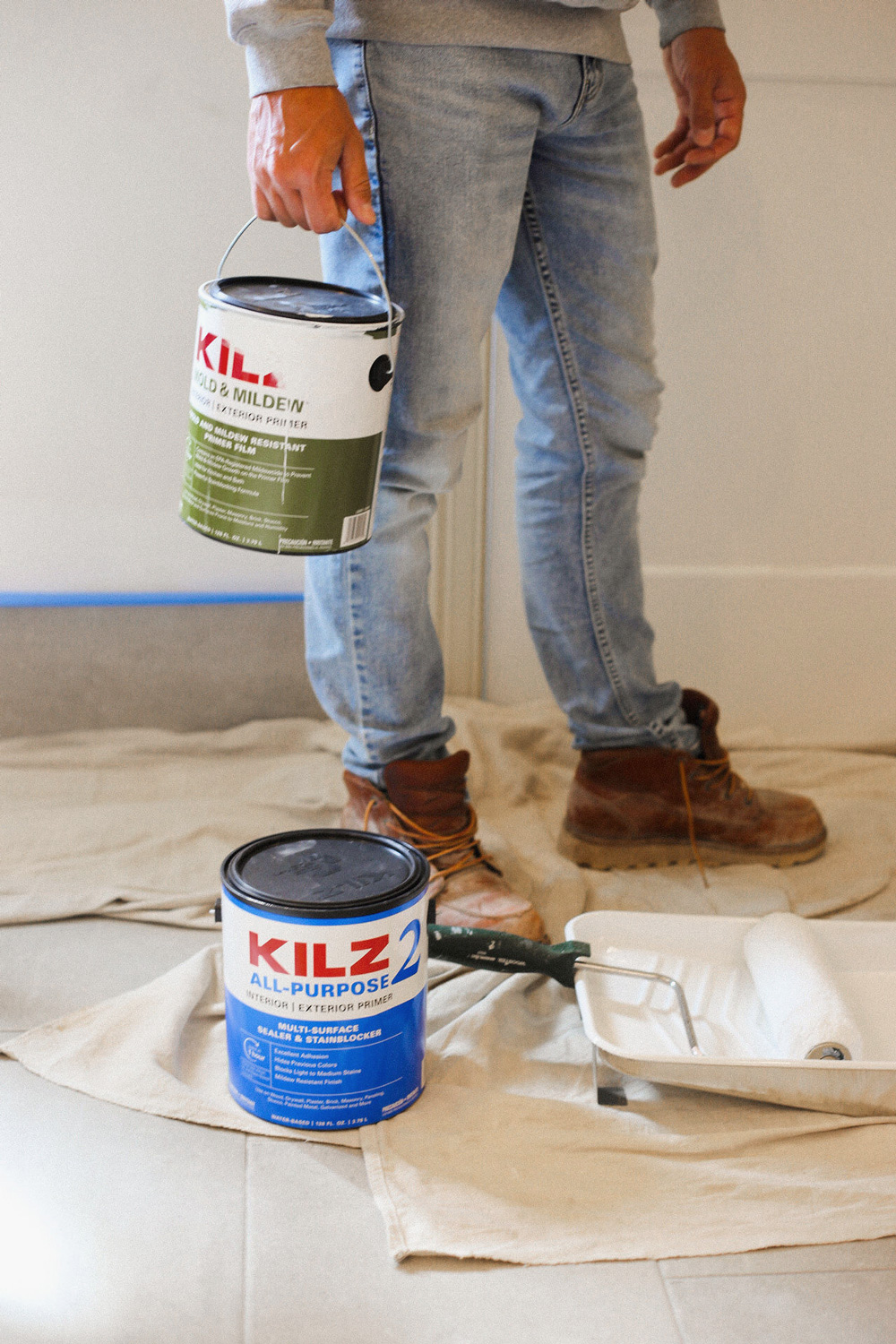
• KILZ® MOLD & MILDEW Primer (walls)
• KILZ 2® ALL-PURPOSE Primer (cabinets)
One of our go-to choices is the KILZ® MOLD & MILDEW Primer, a remarkable solution for moisture-prone spaces like a bathroom. We selected this primer for the walls and shower ceiling because of its mildew-resistant properties, in addition to its stain blocking abilities. This primer serves as an effective barrier against mildew growth while offering a solid foundation for the paint to adhere to, ensuring the paint’s longevity on these surfaces.
We opted for the KILZ 2® ALL-PURPOSE Primer when tackling the cabinets in our project due to its versatile nature and impressive adhesion. It also became our preferred option for the cabinets due to its ability to adhere effectively to different materials, ensuring a smooth and durable base for the paint application. Its quick-drying feature allowed for efficient progress in our project timeline. We appreciated its ability to block minor stains and provide a consistent surface, contributing to a flawless finish for the cabinets.
WALL PAINT
The KILZ® primer and Magnolia Home by Joanna Gaines® by KILZ paint created the perfect primer and paint combination for this bathroom. Both their durability and quality ensure that the tranquil spa ambiance we created becomes an enduring part of the everyday routine.
Our clients were looking for a light, bright aesthetic infused with a serene spa-like vibe for this makeover. The chosen white paint hues, coupled with creamy and natural elements, were the perfect combination to achieve this serene ambiance.
Silos White from Magnolia Home by Joanna Gaines® by KILZ Premium Interior Paint has become a go-to choice for our primary bath projects because it delivers a timeless look. This specific shade offers a beautiful blend of warmth and crispness, creating an airy and refreshing feel within the space while also making it feel larger.
We chose Silos White for the walls in this primary bath due to its ability to effortlessly pair with different textures and materials, such as tiles, countertops, and fixtures. It’s a neutral white with warm undertones that harmonize with a wide range of design styles, allowing for flexibility in decor choices while maintaining a cohesive look.
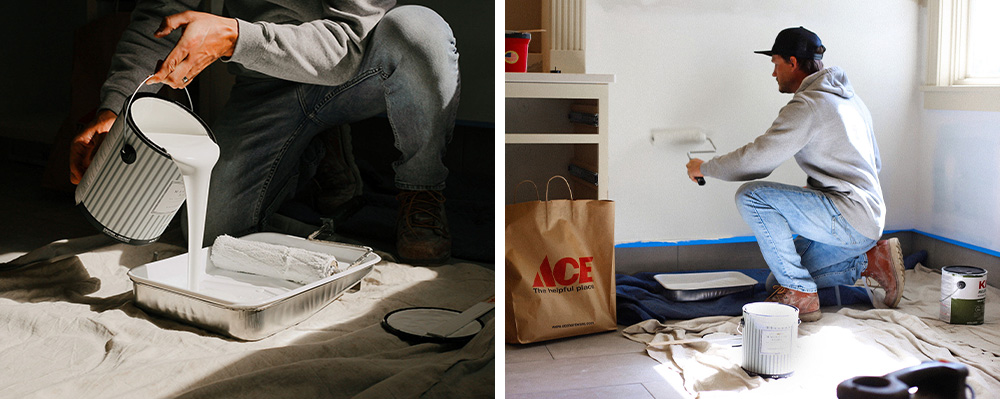
CABINETRY AND MILLWORK
We intentionally chose Magnolia Home by Joanna Gaines® by KILZ Cabinet Paint in True White for the cabinetry and millwork to achieve a refined and cohesive aesthetic. True White emerged as the perfect selection due to its truly pure white hue and timeless allure.
True White has the ability to bring a sense of freshness and sophistication to the space. It boasts a pristine quality that not only brightens but also seamlessly pairs with various design elements, contributing to a clean and polished appearance. Silos White, with its calming and serene nature, served as an excellent backdrop for the cabinetry finished in True White. The synergy between True White and Silos White was intentional, aiming to create a cohesive and inviting space as these paint colors complemented each other seamlessly.
By incorporating True White for the cabinetry and millwork alongside Silos White on the walls and leveraging KILZ® MOLD & MILDEW Primer and KILZ 2® Primer as preparatory steps, we achieved a harmonious and elevated design. This intentional selection of paints and primers played a crucial role in establishing a timeless and lasting finish within the Wayzata Classic Bath.
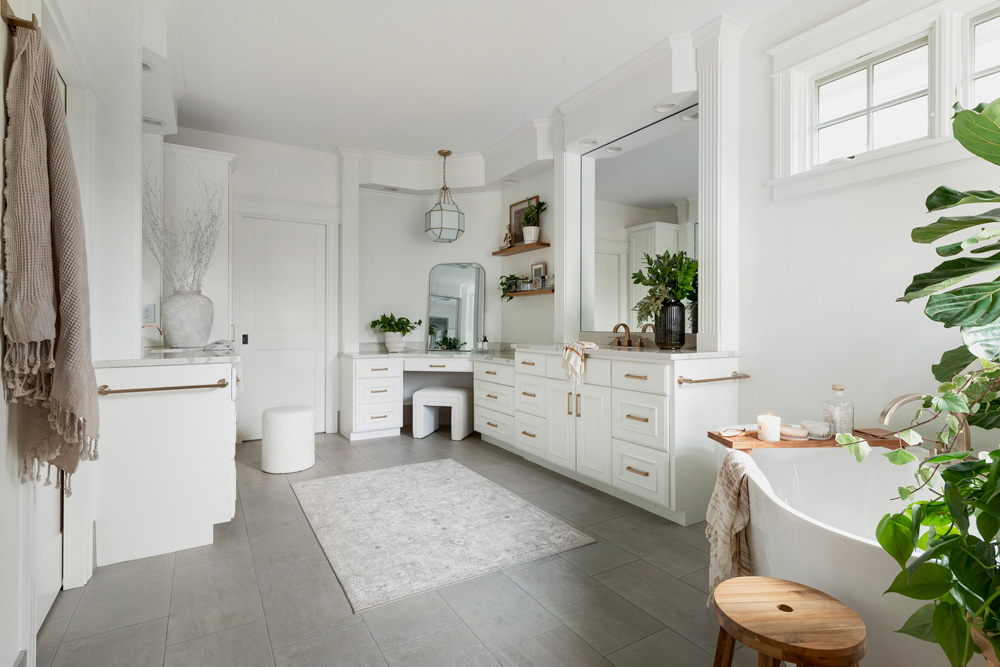
*This is a sponsored blog post with c2s.
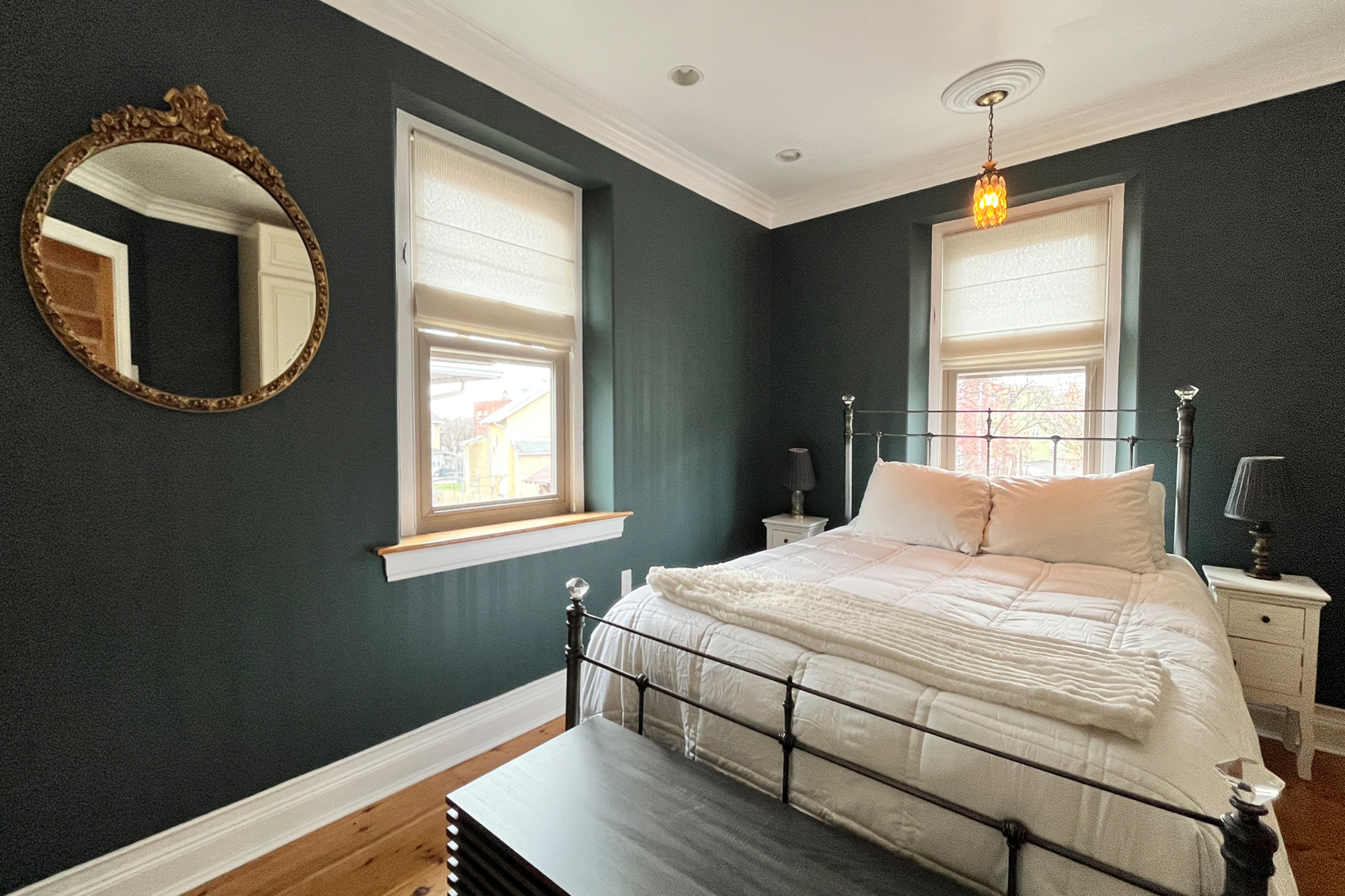
How to Transform an Ordinary Primary Bedroom into a Sophisticated Sanctuary
December 19, 2023As a Certified Aging-in-Place Specialist (CAPs) and certified color consultant, I share DIY projects, tool how-to guides, and home makeovers as a book author, home show speaker, DIY workshop coach, and radio host. I contribute regularly to BobVila.com and Architect and JLC magazines. I’ve been lucky to create fast-paced makeovers for TV shows, and enjoy sharing home trends and DIY tips as a guest on news shows and satellite media tours for TV and radio.
Our primary bedroom was more than ready for a paint makeover. It was not the rejuvenating sanctuary that we needed while managing a busy household, especially with the added pressure of the holidays.
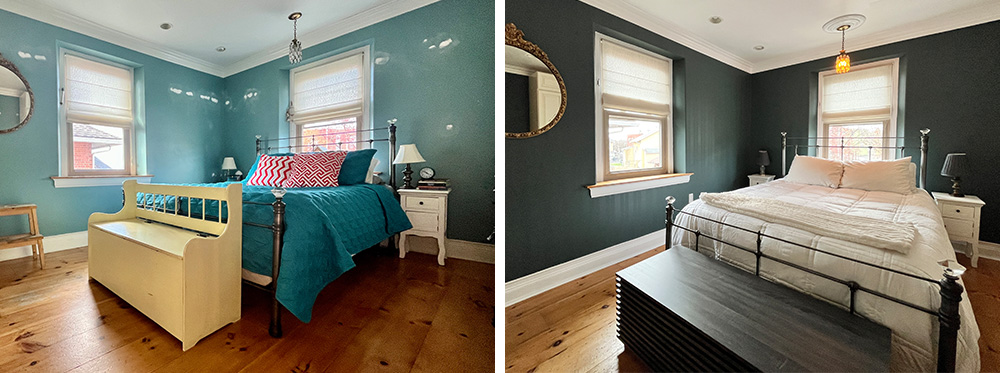
What’s the makeover motivation?
I started paint prep during the pandemic, and never actually painted the room. We’ve been living with patched walls for way too long, and it was time to give the room a refresh.
The goal was to create a more sophisticated and modern look with a richer and more soothing hue that exudes a calm and relaxing vibe. By painting the walls using contrasting sheens to create a stripe pattern, I’m adding subtle sophistication through gentle texture that will catch the light from the overhead dimmable lighting.
Select the color.
You’ve probably heard the advice from designers to paint a few samples on the wall before selecting the paint color for a room. It’s such a common tip that paint companies often offer small samples for less than $10. While I agree with this advice, there’s a step that’s missing.
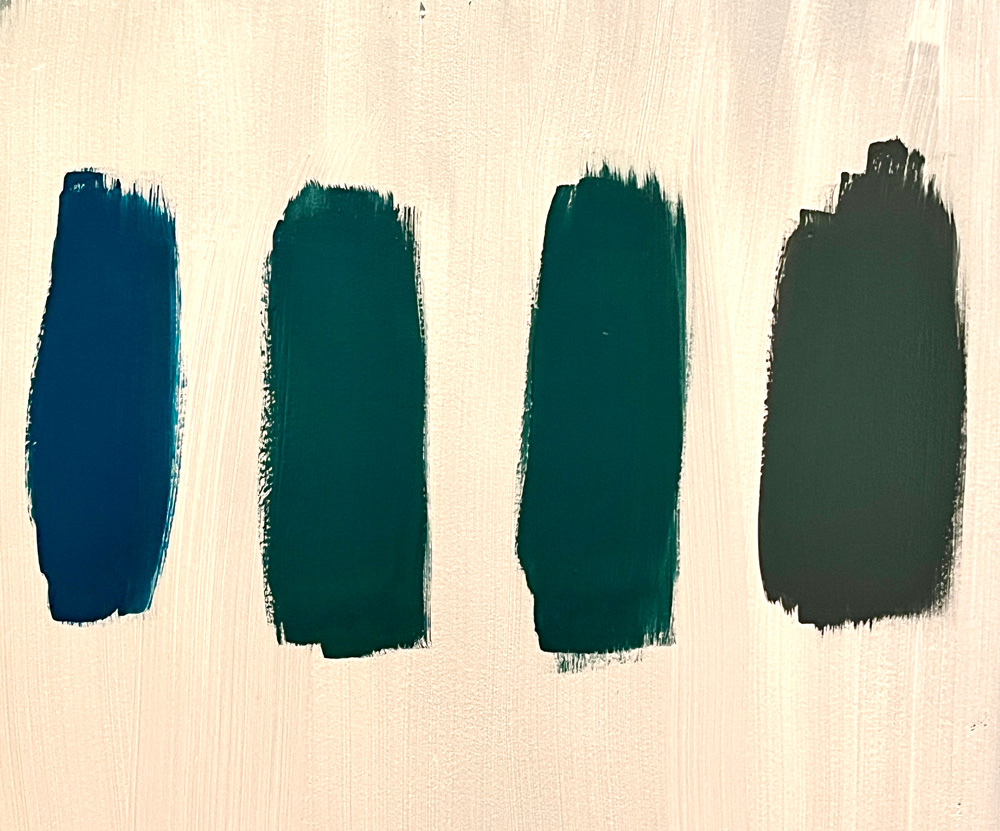
It’s important to prime the wall before applying the sample colors. For this project, I chose KILZ 3® PREMIUM Primer to prime ahead of painting. The current color on your walls can affect how the new color looks to you and whomever else is picking the paint. Then make sure you view the samples during the day, at night, in natural light, and with artificial light, so you have a good idea of what the color will look like throughout the day.
Also, don’t unload the room before putting the samples on the wall, especially if you plan to use the same furnishings in the room after the paint job is complete. The reason? The colors from the other home decor items can affect how a paint color looks to you.
For this project, I chose four colors and asked my husband Mark to pick his favorite. He chose Secondhand Find from Magnolia Home by Joanna Gaines® by KILZ (the color on the right), which is a rich and very saturated bluish-green. An excellent modern color that fits with our goal of a calm and sophisticated vibe.
Select the primer.
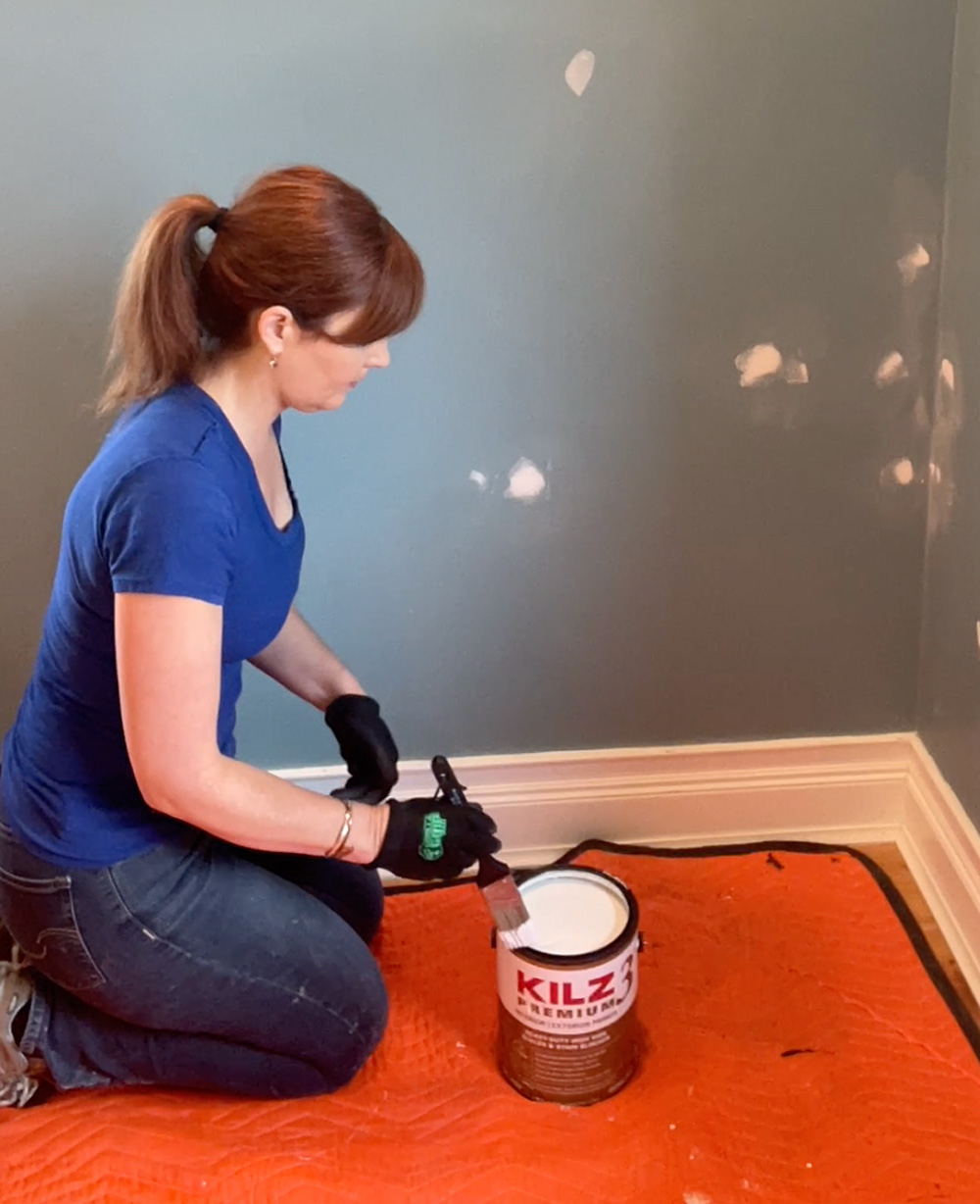
While you might be tempted to skip the primer or choose a paint-and-primer in one, we don’t. We always use a high quality primer because it sets the foundation for a good quality paint job and a professional finish. Even though the KILZ brand partnered with us on this makeover, KILZ has been our go-to primer for more than a decade because it delivers long-lasting results for our home and our clients’ homes.
For this project, we chose KILZ 3® PREMIUM Primer because it’s fast drying, low odor, very low VOC, and it has excellent adhesion. The thicker formula also hides surface imperfections, which is ideal for this house that was built in 1903 and has a lot of ‘character’ marks from the previous owner and our busy family.
Gather primer, paint, tools, and materials.
The next step in this makeover is gathering the tools and materials. For this project, I needed:
• Drop cloth (We like to use a moving blanket because it has more weight to it.)
• Multi-tool
• Awl
• Hammer
• Ladder
• 1½-inch angled paint brush
• Paint roller and extender
• Paint tray
• Painter’s tape
• Paint Samples in selected colors
• Magnolia Home by Joanna Gaines® by KILZ Interior Paint in Secondhand Find, Matte Finish
• Magnolia Home by Joanna Gaines® by KILZ Interior Paint in Secondhand Find, Eggshell Finish
Paint the trim.
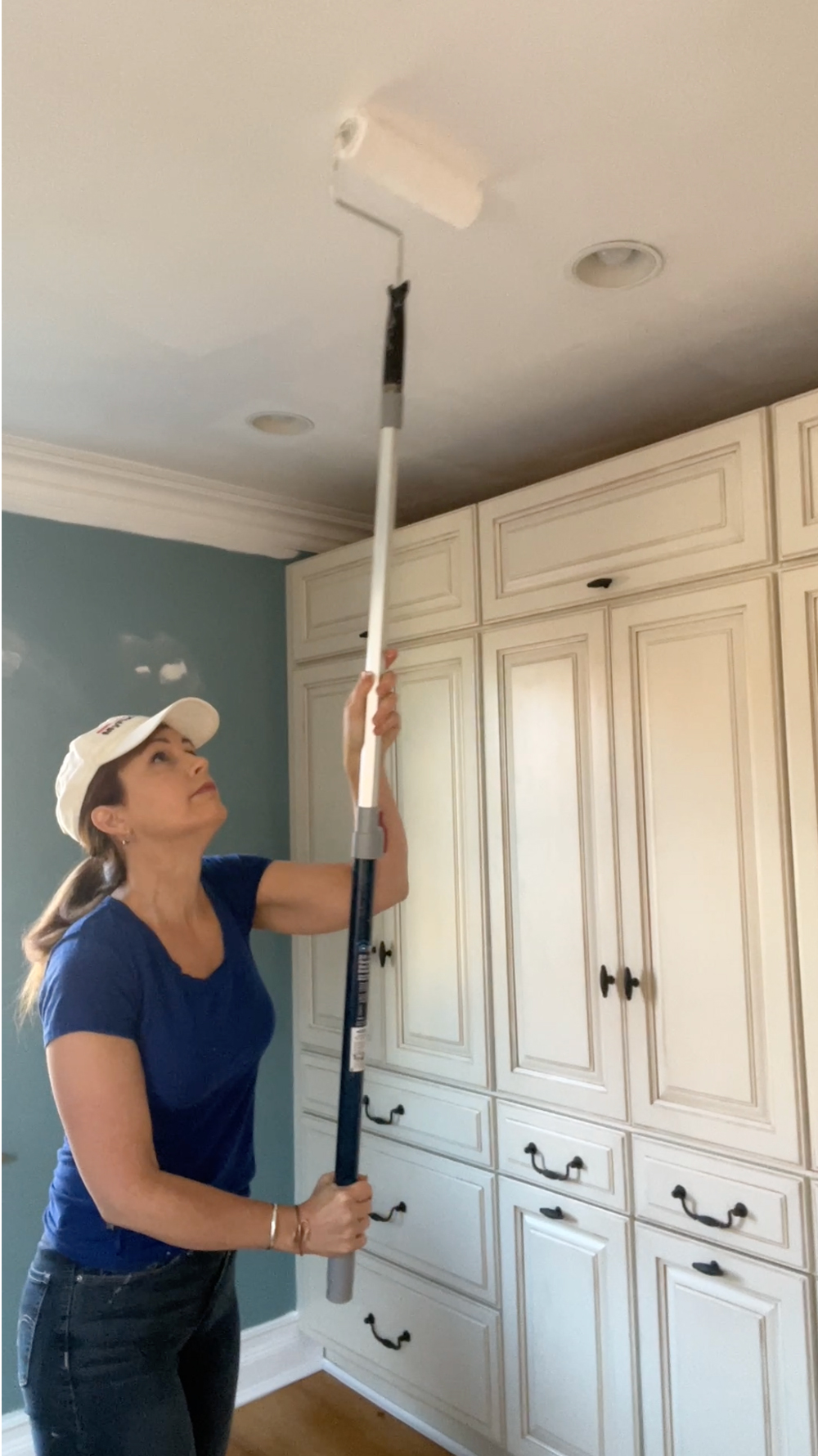 While many might paint the ceiling or prime the walls first, we don’t. We often paint the trim first, especially if the ceiling has previously been primed and painted white and will be painted white again, and if the trim will be painted white. The reason is that it’s easier to go quickly and over-paint the trim on the first pass, and then cut in the ceiling and wall color later. We find that it gives the trim a crisper line.
While many might paint the ceiling or prime the walls first, we don’t. We often paint the trim first, especially if the ceiling has previously been primed and painted white and will be painted white again, and if the trim will be painted white. The reason is that it’s easier to go quickly and over-paint the trim on the first pass, and then cut in the ceiling and wall color later. We find that it gives the trim a crisper line.
I used Magnolia Home by Joanna Gaines® by KILZ Interior Paint in True White, semi-gloss finish for the trim, and gave it two coats.
Paint the ceiling.
The next step before priming the walls is painting the ceiling. Since this ceiling was primed before and is painted flat ceiling white, it didn’t need another coat of primer, just a fresh coat of white paint. I used Magnolia Home by Joanna Gaines® by KILZ Interior Paint in True White, matte finish.
If the ceiling was freshly installed drywall, was looking less-than-stellar, or was painted a color other than white, I would have primed it first. Still, I painted two coats.
Prime the walls.
After the ceiling and trim were done, it was time to prime the walls. I first cut in the primer using a brush along the painted baseboard, and then the inside corners and other areas that a roller can’t fit: along the window sill, window trim, door casing, and our built-in cabinets
I then primed the joint compound patches all over the walls. While KILZ 3® PREMIUM Primer is thick and hides imperfections, I still wanted to be sure that the patches would disappear after rolling out the primer. This little double primer on the patches is a belt-and-suspenders approach that might not be necessary in your project.
Then I rolled out the field—-the walls—with a paint roller.
Paint the walls.
The primer dried super fast, so I didn’t have to wait long to start cutting in the color on the walls. (I can’t tell you how much of a joy it is to not wait long for paint to dry.) I started by cutting in the wall color along the baseboard, window trim, door casing, and cabinets. And then used the paint roller to finish. The color immediately popped on the wall, which is a sign of a good primer. Still, I painted two coats.
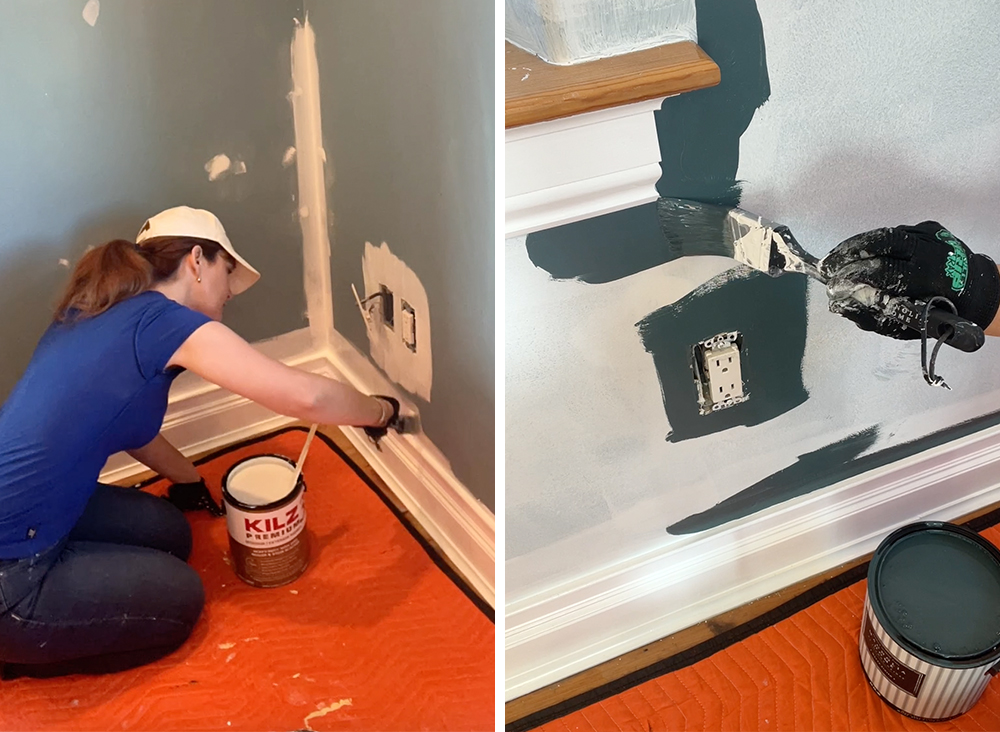
Paint the stripe.
After the paint was dry, the next step was painting the stripe. I’ve been dreaming about painting a contrasting sheen in the same color for years, and was very excited to finally create the look. The idea is to use a flat or matte color and then use the same wall color but in another sheen. For this project, I chose eggshell, since we wanted to create a subtle and calm vibe. If I was creating a dining room or a playroom, I’d probably choose a different combination of sheens for greater contrast.
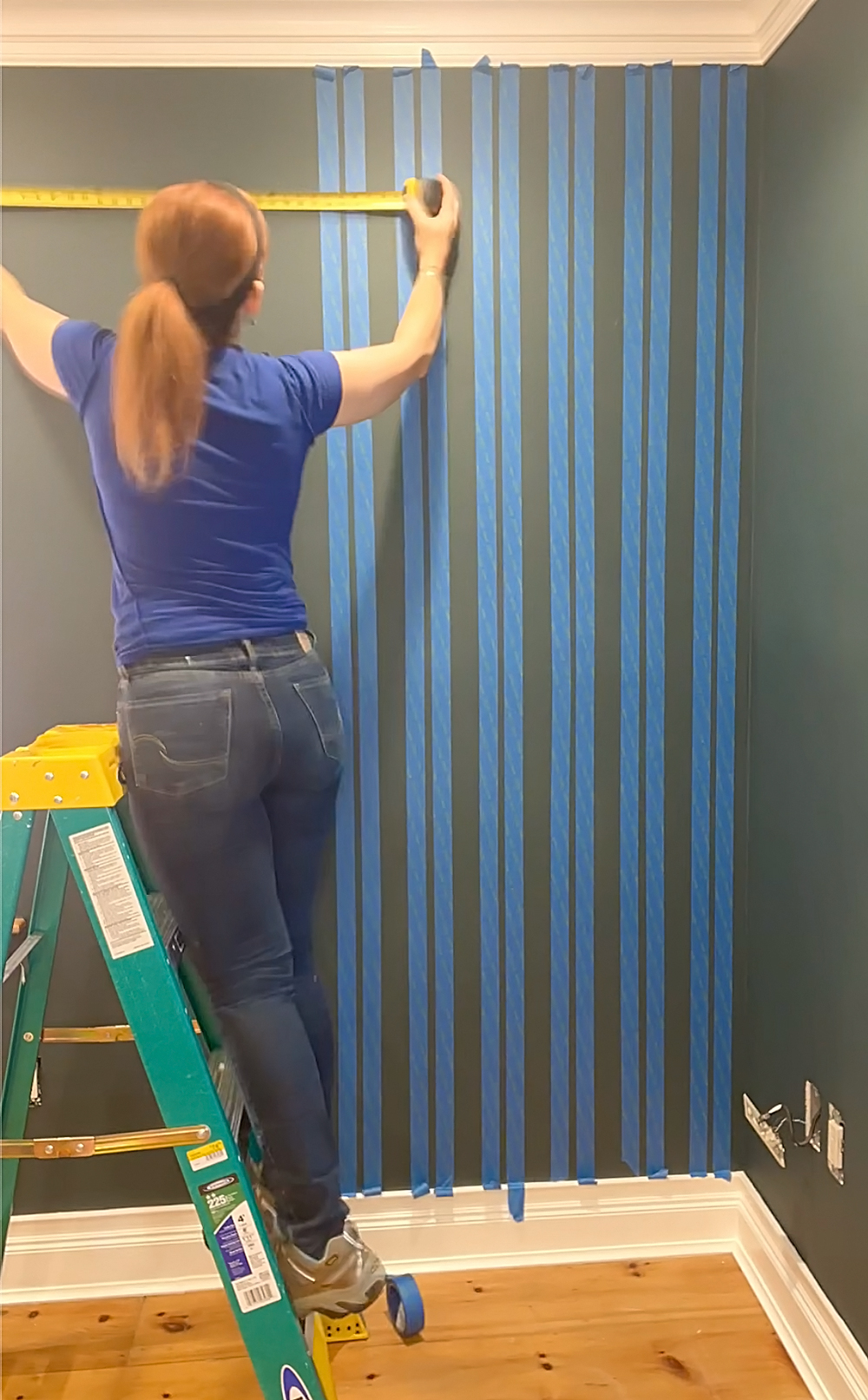
After marking the layout of each stripe with a tape measure, level, and pencil at the top, middle, and bottom of the wall, I extended the painter’s tape from the top of the wall to the bottom. For a stripe to work, it needs to look vertical and consistent. So, after each set of stripes, I checked for plumb and measured the distance between the stripes to be sure I was on the mark.
The painstaking part is applying the tape. The fun part is applying the paint. But, before painting, I make sure that every bit of tape is adhered to the wall so that no paint can infiltrate beneath it. Then I rolled Secondhand Find in Eggshell on the wall. After waiting for the first coat to be dry to the touch, I applied a second coat. And then I removed the tape. I make sure to keep a low angle to the wall when I remove the tape so it comes off without messing with the paint on the wall.
No, I don’t wait for the paint to dry to remove the tape, as it can take a long time and it can be more difficult to remove. Just be sure to have a trash bag ready to drop the wet tape into after removing each strip. It can be a mess if you need to go searching for a place to dispose of the bundle of wet tape.
Update the decor.
When the paint was dry, the electrical faceplates needed to be put back. Before rehanging the antique pineapple light, I installed a ceiling medallion to help accentuate the little glass light fixture so it looks less like an afterthought and more like a featured player in our primary bedroom.
The old bedspread was swapped for a white quilt, the bedside table lamps have new shades, and the antique mirror went back in its spot. Since the yellow deacon’s bench is a family heirloom, we decided to use it in another room, and swapped it out with a backless modern bench that fits in better with the goal vibe.
Now we have a hotel-like sanctuary to retreat at the end of each day, instead of a looming project with decor that didn’t quite go together. It’s a calm primary bedroom with a perfect paint finish.
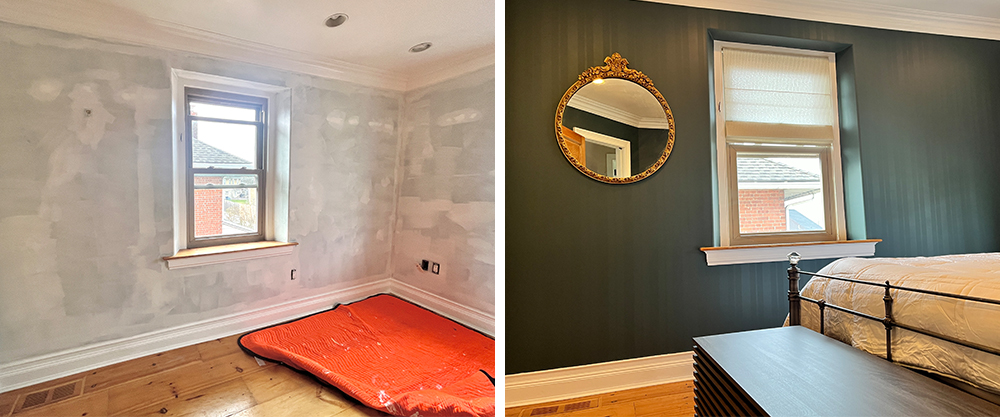
Learn more at kilz.com
*This is a sponsored blog post with MyFixItUpLife.
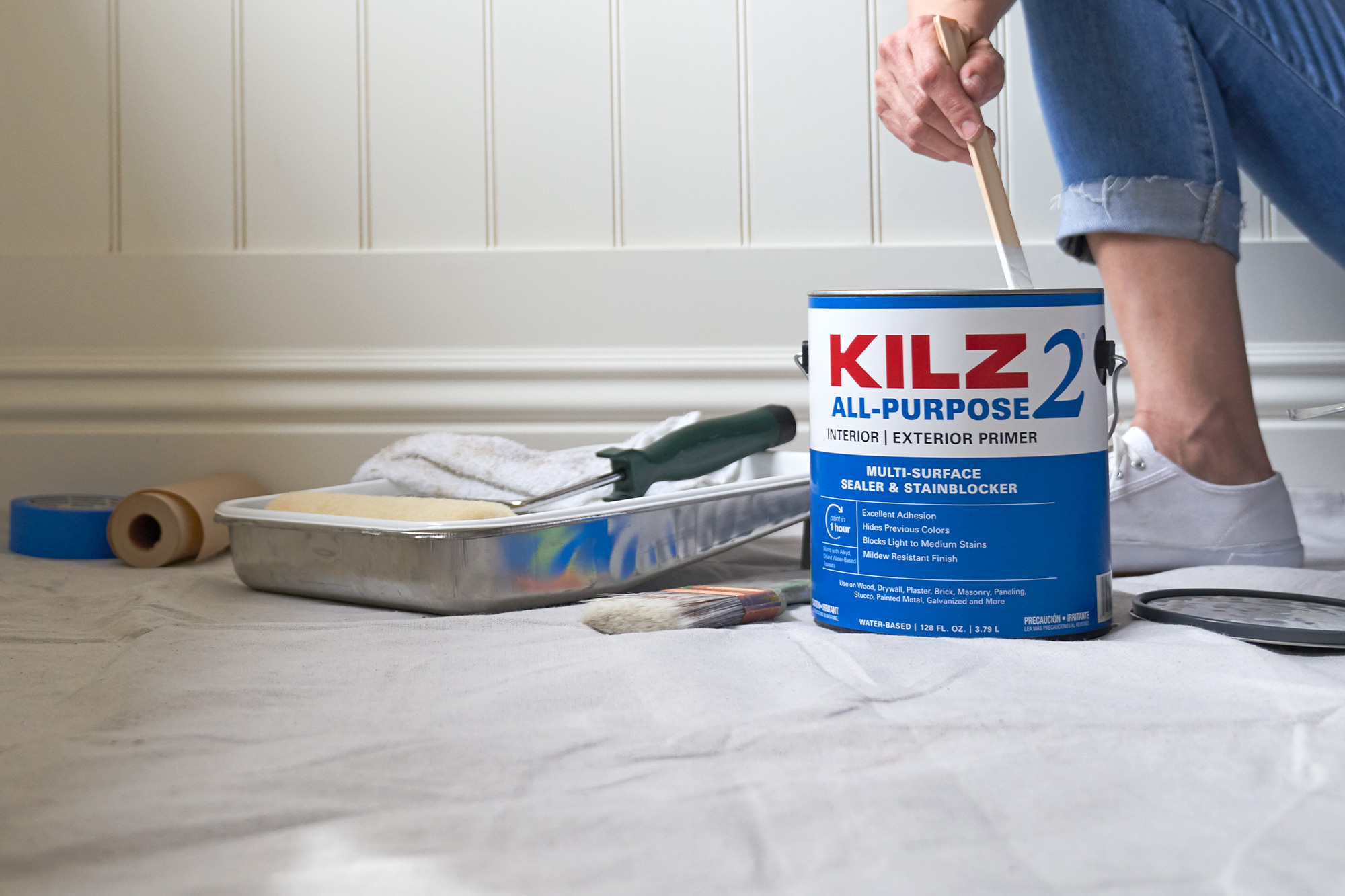
Best of Primer Tips: What Did We Learn This Year?
November 21, 2023To inspire another productive year ahead, let our pro primer tips 2023 recap be your guide. You already know how important a good primer is to any successful painting project, but the finer point may be less clear. That’s why we’re recapping some of the best primer tips of the year and taking a moment to appreciate just how much we learned.
Tip #1: Save time, money, and labor by using primer.
Because it is formulated to solve specific problems before you paint, primer creates an ideal surface for lasting results. This means there’s less likelihood that you’ll have to retouch or redo a project in the short-term. By sealing porous surfaces evenly, for example, you’ll use fewer topcoats, and since primer costs less than the topcoat, using a primer first and then applying the topcoat is cheaper than applying multiple coats of topcoat only.
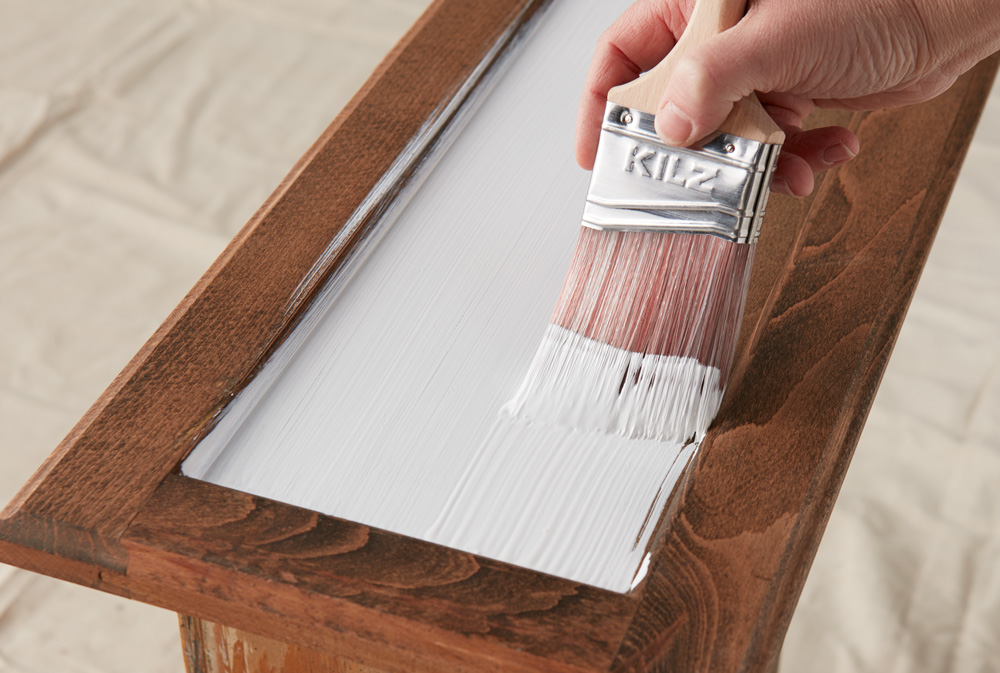
Tip #2: Choose the right primer for your substrate.
Before beginning any painting project, identify the type of surface you want to prime and paint. Different substrates accept coatings differently, which is why KILZ formulated a primer with each surface type in mind. Also take note of your surface’s condition. What circumstances should be addressed before applying a coating? Lastly, identify the environmental conditions where the surface is located. Is it damp? Will it be exposed to weather damage and temperature fluctuations? Each of these conditions dictates the primer and paint you choose to use.
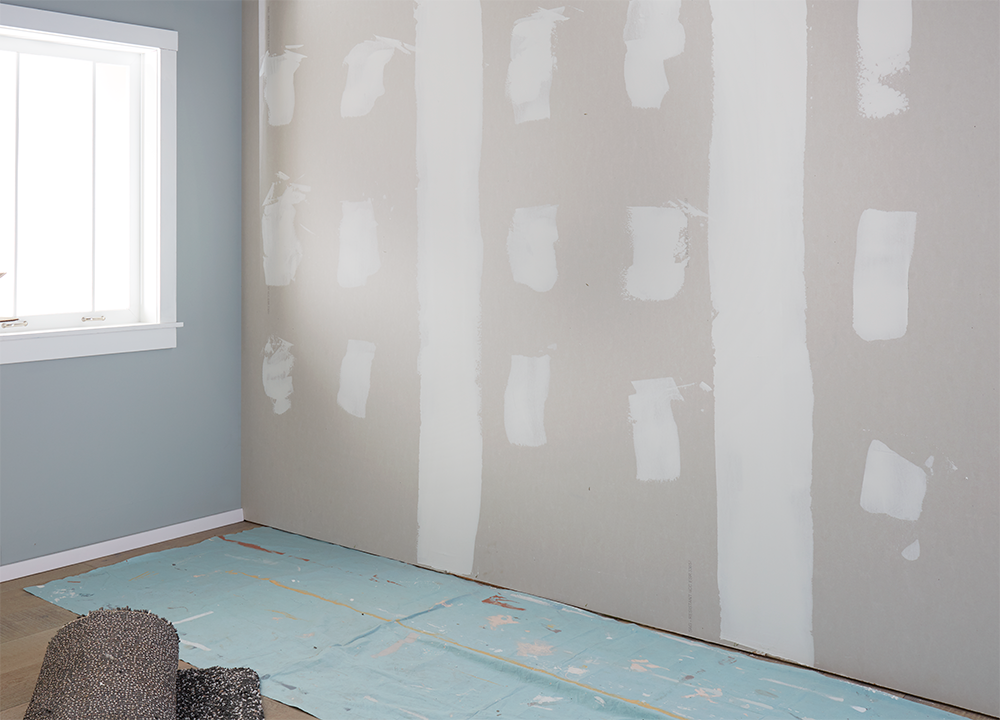
Tip #3: Know your project details ahead of time so you can prepare.
Preparation is key before starting any paint project. You should know the products you’ll need and what steps to follow. For most projects, you can trust a multi-surface primer to prepare the surface for painting, but more complex situations require a specialty formula primer—such as mold, stains, and odors. Preparing for the job beforehand will help things run smoothly from start to finish. Not sure where to start? Review this checklist.
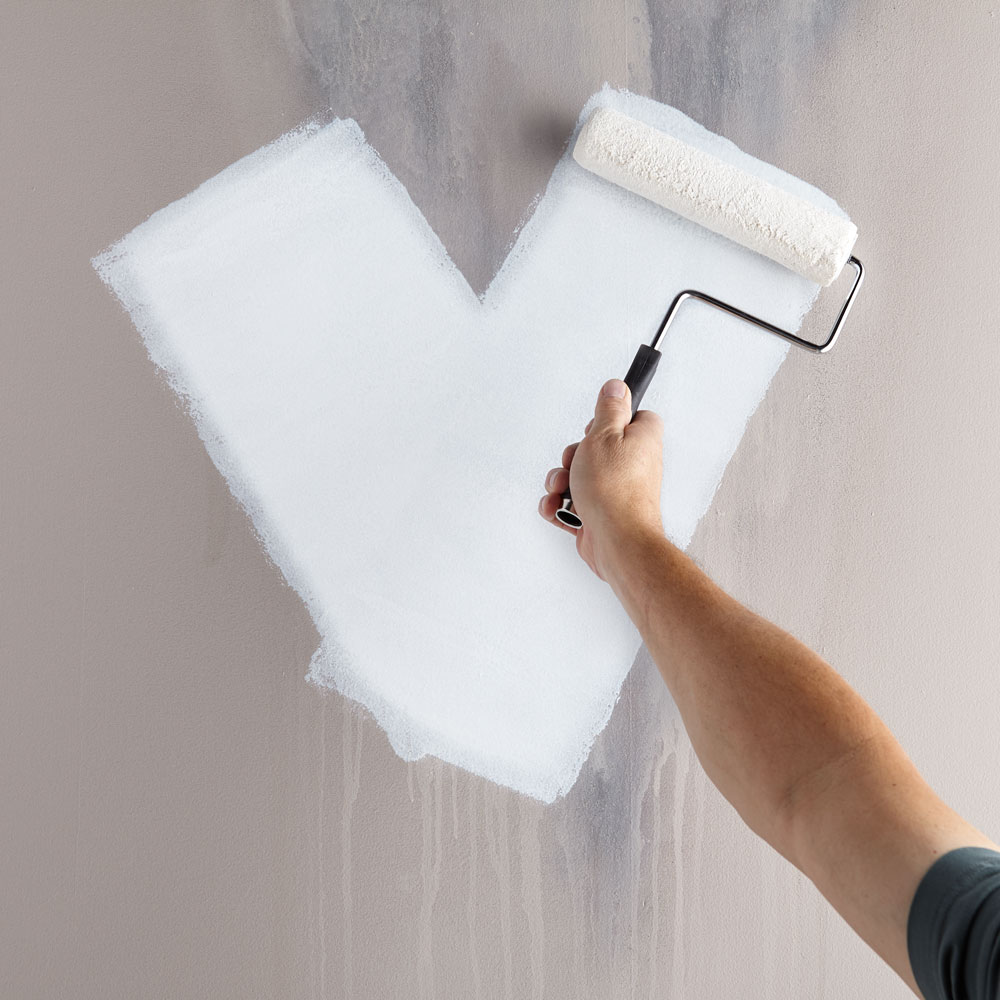
Tip #4: The right application can make a big difference.
Quality usually comes at a higher price than a cheaper alternative, but the results are worth it. Besides selecting a quality applicator, the construction of the applicator should be compatible with the chemistry of the coating being applied. Some brushes are built for water-based products, some are designed to work with oil-based products, and some will work with both. Most rollers are compatible with oil- and water-based products. This information is usually listed on the packaging, so make sure to check for it when choosing an applicator.
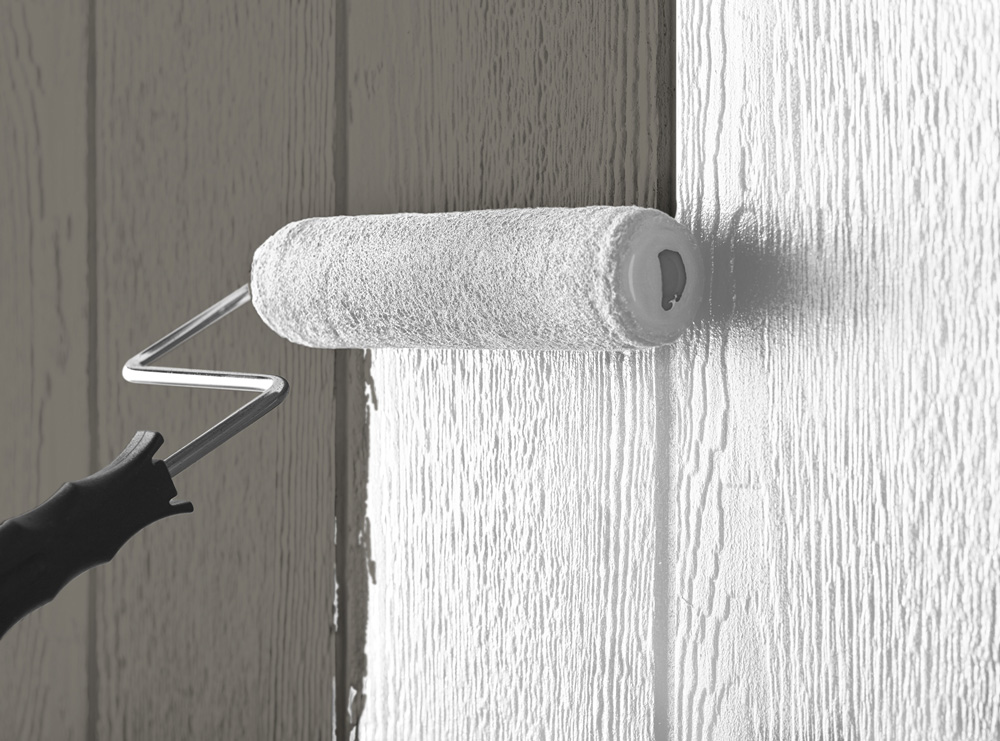
Tip #5: Know when to use primer and when paint & primer in one will work.
The idea of saving time and money by skipping a step in the painting process is appealing, and while many paint and primers in one (PPIO) boast this claim, it’s not always that simple. While it can work for some jobs, more specialized products will give you better results depending on the situation. For example, PPIO can work well on pre-painted surfaces without a drastic change in color or texture, but this is possibly the only reason to choose it. If your job is more complex than that, it’s best to opt for a specialized primer in addition to paint.
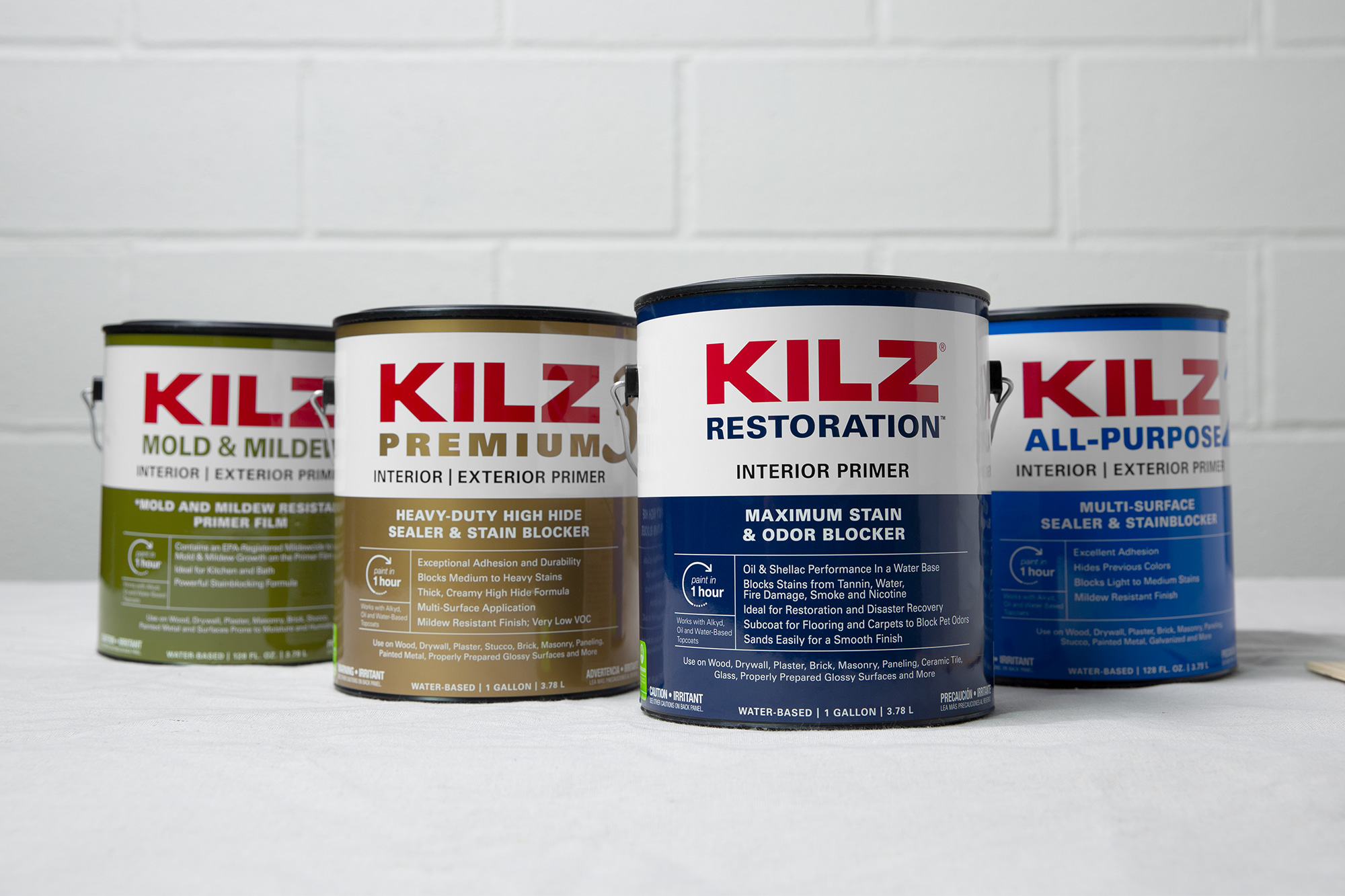
Tip #6: Understand the different types of sheen and choose wisely.
If chosen incorrectly, sheen can amplify surface imperfections, make a surface shinier (or flatter) than intended, or not provide enough durability for the space. Some sheens are easier to clean than others and can provide a barrier against moisture, mildew, and other grime. The darker and richer a paint color is, the more colorant it contains, which boosts sheen. If you’ve chosen a rich or dark paint, and you don’t want it to turn out super shiny, choose one with a lower sheen. In the same vein, if painting a large, sun-washed, or flawed surface, a lower sheen paint is best for hiding imperfections.
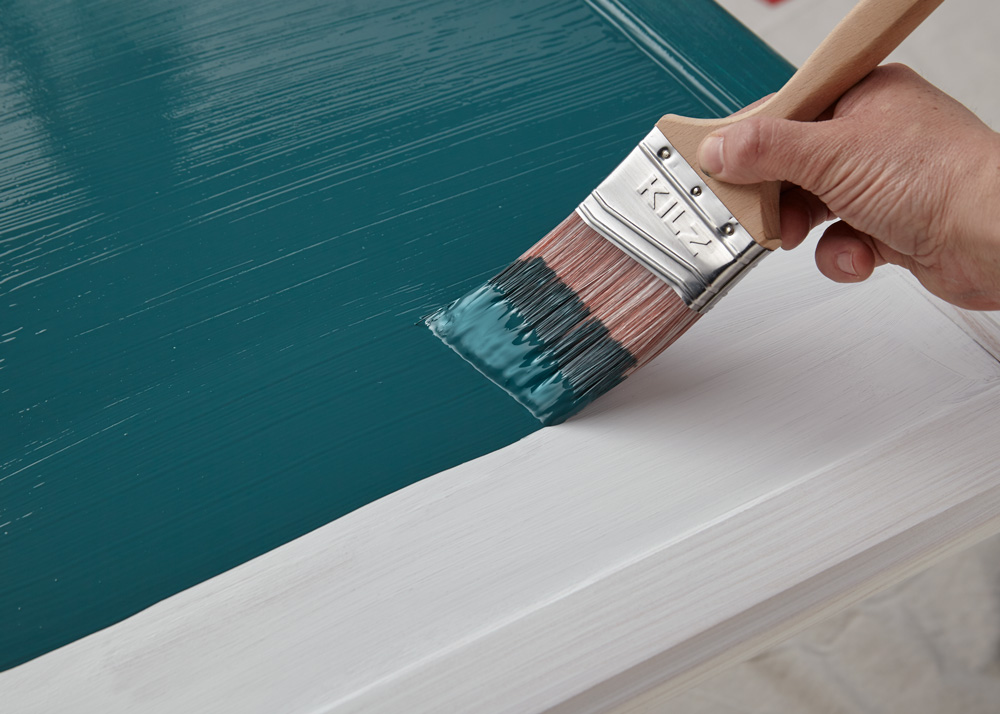
For more helpful tips like these, be sure to check back in with us so that you can tackle all your future projects with confidence. KILZ® Primers are here to make your DIY dreams a success. We hope you had a productive year and can’t wait to see what will inspire you in 2024.
Always remember to refer to our website kilz.com or product back labels for additional information on which primer is right for your project and detailed instructions on how to apply our products. Check out our Coverage Calculator to understand your estimated paint needs for your upcoming project.
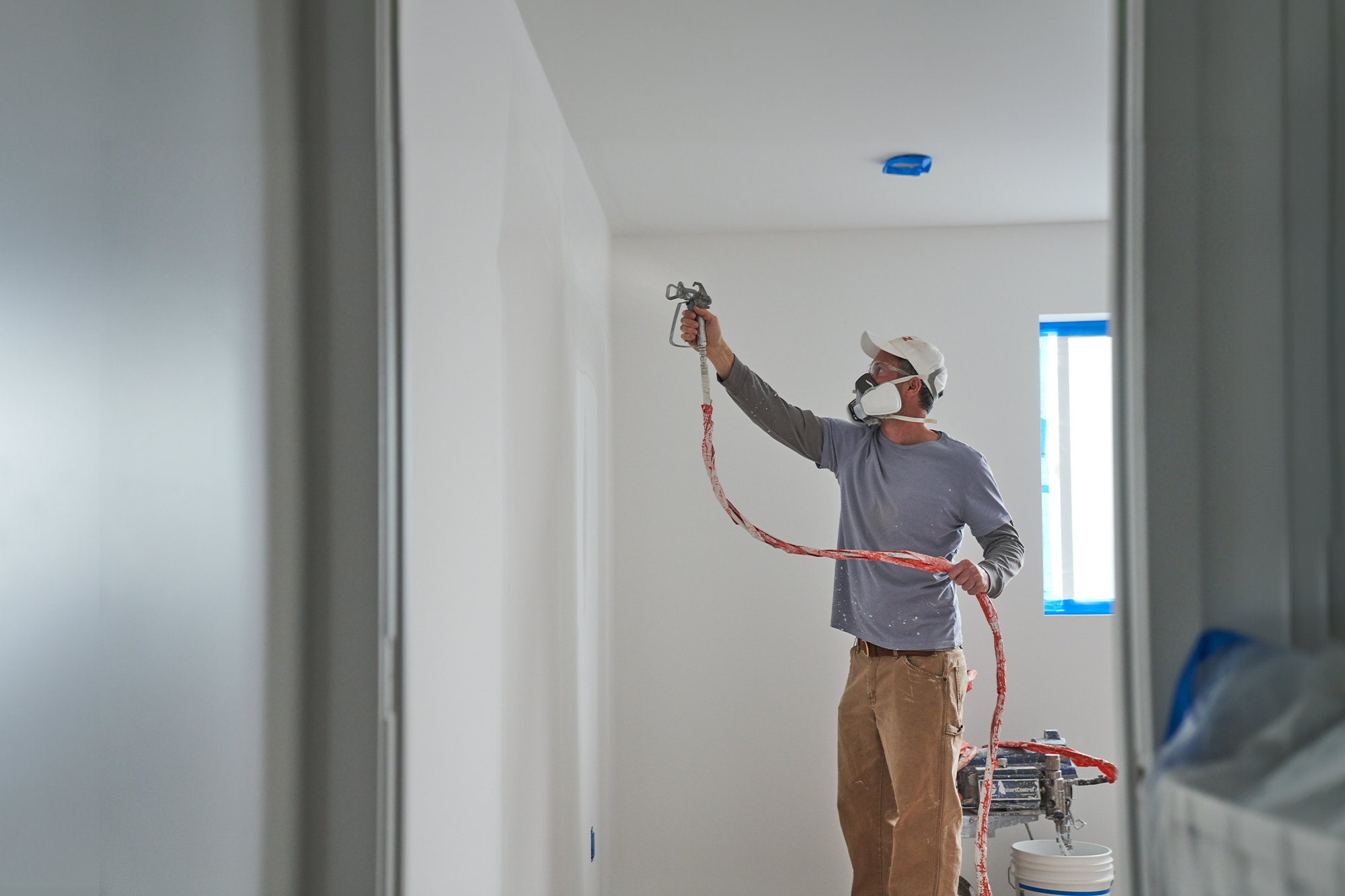
Tinting Primer
October 31, 2023What is tinting primer and what is the purpose?
Primer acts as a base coat and helps the paint adhere to the surface. Tinting the primer can help you achieve color matching with your desired paint color in fewer coats.
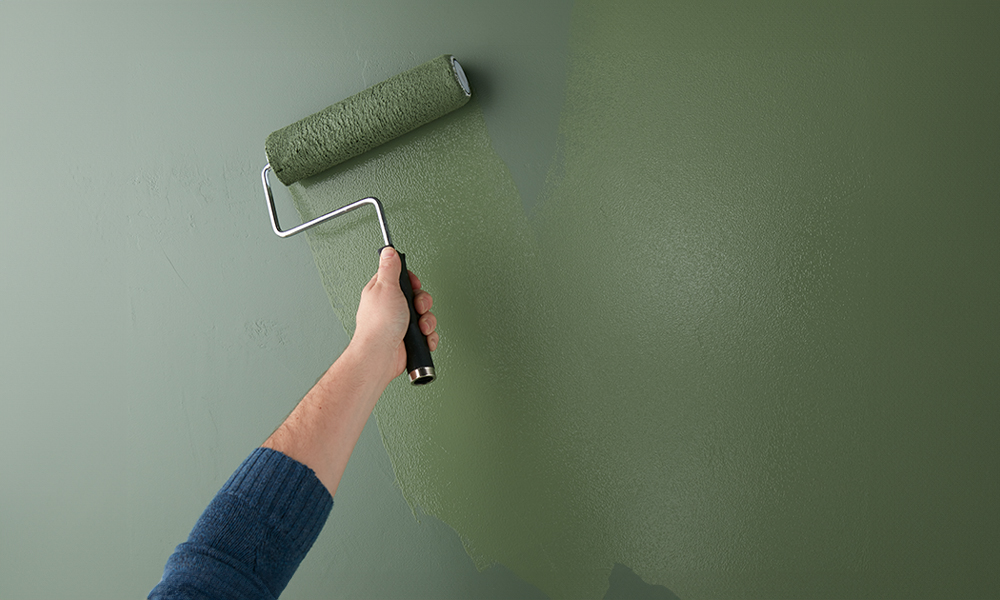 When is tinting primer necessary?
When is tinting primer necessary?
It is not absolutely necessary but recommended to help the topcoat paint achieve its true color in fewer coats. By tinting the primer especially if painting dark, deep, and rich colors or going from darker shade to a lighter one, it will lessen the work and coats needed to closely match the desired topcoat color.
Can I tint primer for drywall or previously painted walls?
Yes, most primers are white in color and can be tinted to a limited color palette.
How do I tint primer? Should I have a professional tint for me?
Most paint stores or home centers that sell paint have tinting machines and associates/employees who know how to do this.
Is there anything I should know before tinting the primer?
Label instructions about tinting of the primer should be followed. It is recommended to tint to a lighter shade than the topcoat color.
Can all primers be tinted?
Primers for residential painting typically come in white color and this is most suitable for tinting. Gray or pre-tinted primers do not need to be tinted. Aerosol primers cannot be tinted.
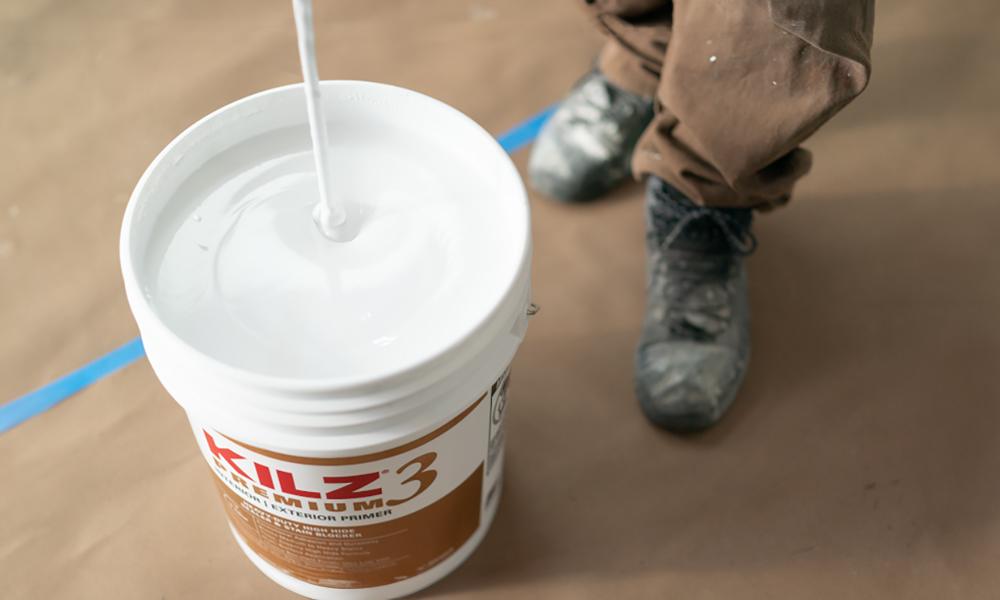
Can you tint a water-based primer?
Yes, water-based primers that are white or light color can be tinted.
Should I tint primer that will be used on mold and mildew?
These types of primers can typically still be tinted unless the label claims it should not be tinted or does not say that it is tintable.
Do I tint my primer with regular colored paint, or with a colorant?
Most paint stores or home centers and hardware stores that sell paint and have tinting capabilities will use tint machines which have the color formulations specific to brand, tint base type and other specifics already in their tint machine software. It is recommended to have the primer tinted in a store using colorants dispensed by a tinting machine.
What is a colorant?
Universal colorants are materials containing a color pigment dispersed in a blend of surfactants and a liquid (most often a glycol). The level of pigment is dependent on the type, color strength and pigment surface area – from paintinfo.com
In what use cases should you not tint primer?
Tinting primers is not needed if you are painting the same color as before or there is little change from the old color and the new one. Tinting primers is particularly helpful to lessen the number the coats needed to achieve truest color and when doing dramatic color changes.
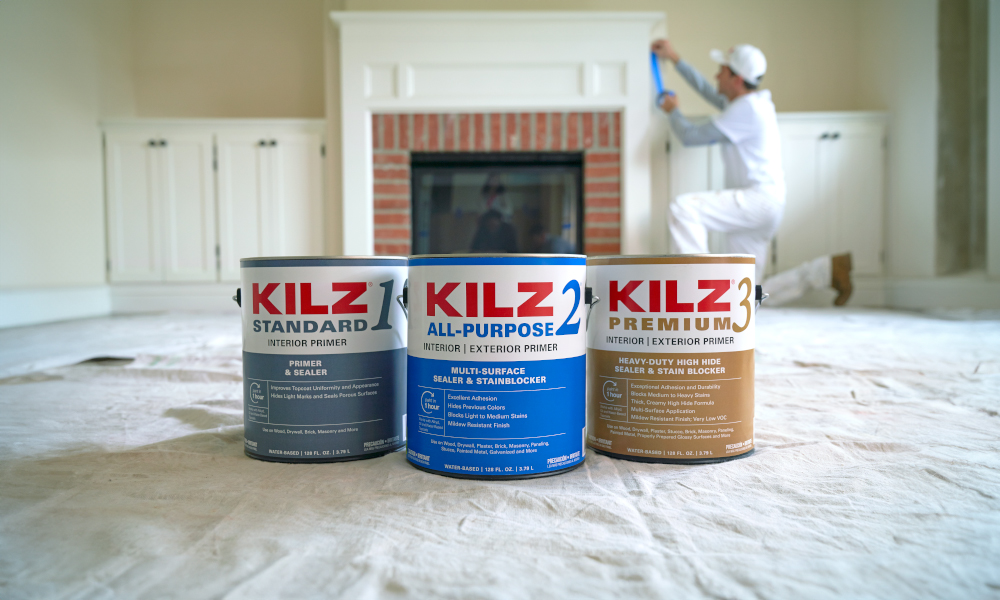
Always remember to refer to our website kilz.com or product back labels for additional information on which primer is right for your project and detailed instructions on how to apply our products. Check out our Coverage Calculator to understand your estimated paint needs for your upcoming project.
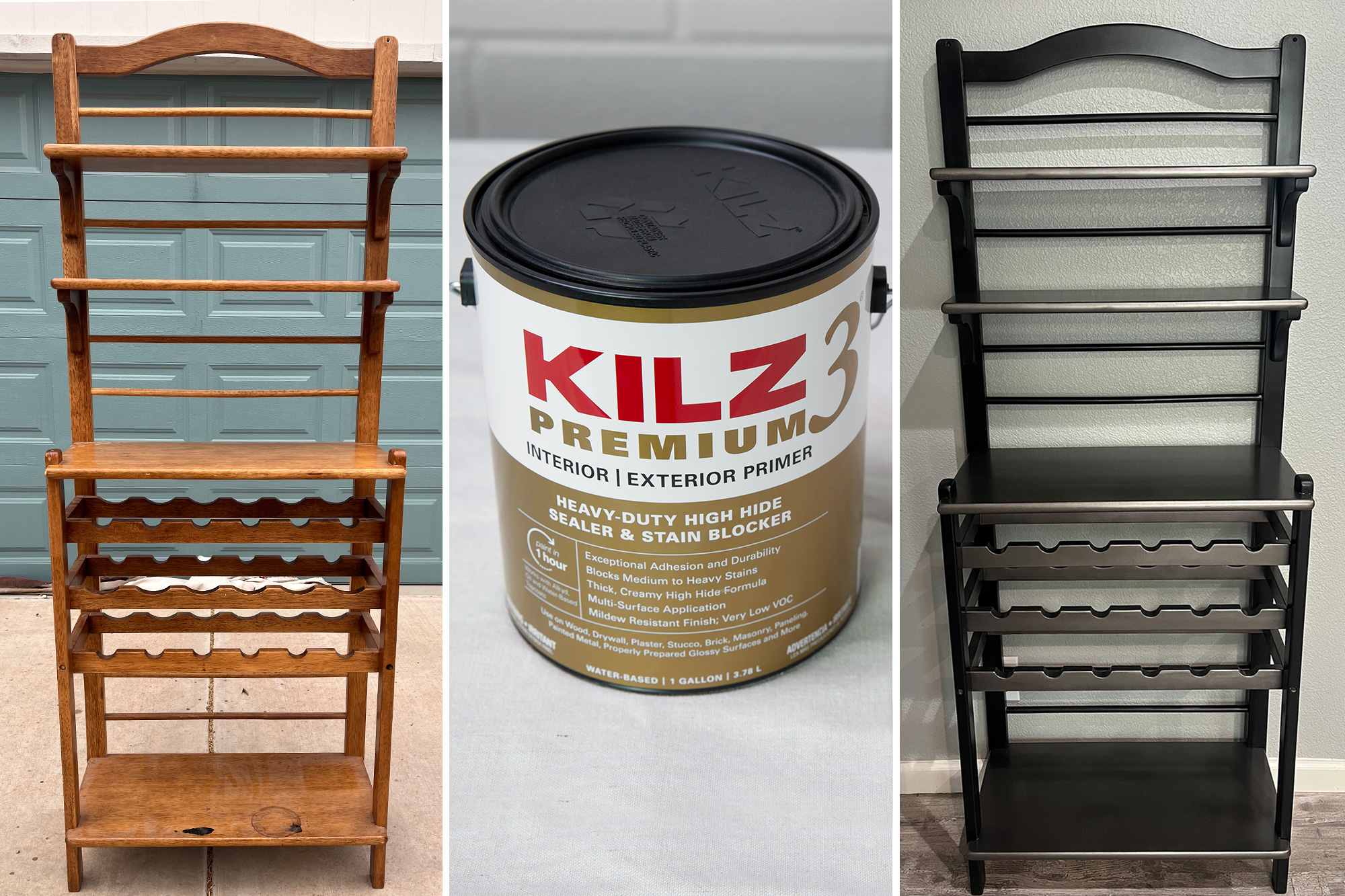
Pro Spotlight: James Mansour Shows The Power of a Good Primer when Upcycling
June 30, 2023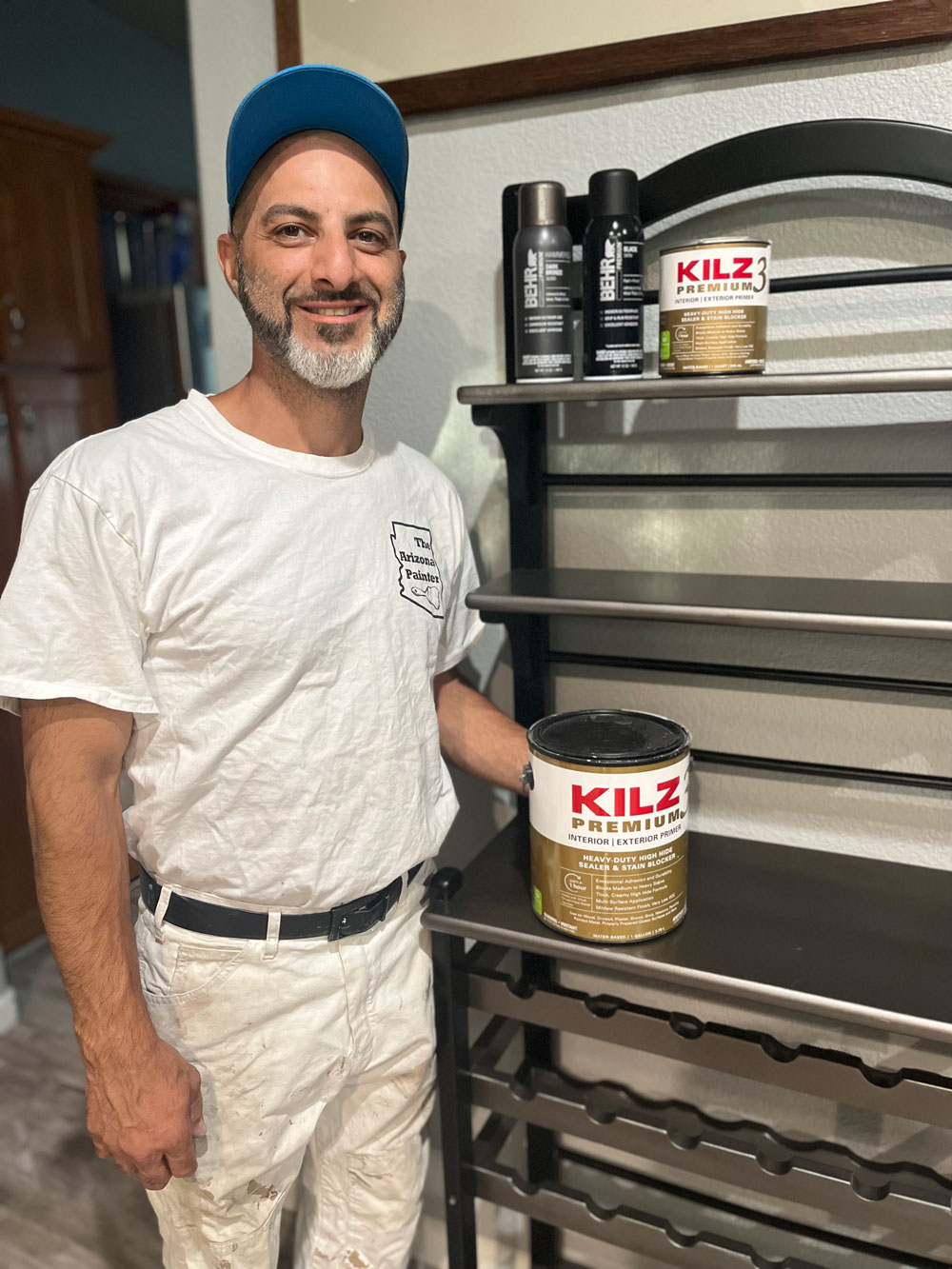 My name is James Mansour, and I am the owner and operator of Mansour Valley Painting in Mesa, Arizona. I also go by The Arizona Painter online where I work to educate and share my love of painting, including the intricacies of the craft. With over 20 years of experience, my company specializes in exterior and interior painting while always emphasizing the importance of proper prep work. I am partnering with KILZ to highlight one of my favorite products, KILZ 3® PREMIUM Primer. I chose a DIY upcycling project because I am a huge supporter of teaching my customers and online audience how to properly prepare surfaces for paint, and then use paint to completely transform an object or space.
My name is James Mansour, and I am the owner and operator of Mansour Valley Painting in Mesa, Arizona. I also go by The Arizona Painter online where I work to educate and share my love of painting, including the intricacies of the craft. With over 20 years of experience, my company specializes in exterior and interior painting while always emphasizing the importance of proper prep work. I am partnering with KILZ to highlight one of my favorite products, KILZ 3® PREMIUM Primer. I chose a DIY upcycling project because I am a huge supporter of teaching my customers and online audience how to properly prepare surfaces for paint, and then use paint to completely transform an object or space.
I love the idea of upcycling. Not only does it allow you the freedom to create a unique accent for your living space, but it is also sustainable and environmentally friendly. Upcycling is a term used to describe the process of repurposing old, unwanted things into unique, creative, and new items. By choosing to upcycle I am also contributing to waste reduction, conservation of natural resources, and allowing myself an opportunity to innovate. I knew I had to find the perfect piece for this project, so I started by paying a visit to a few local Goodwill stores. After much deliberation, I found a wooden wine rack that my wife loved. It was the perfect size and shape for the dividing wall between our kitchen and living room. In order to kick this project off right, I would need the perfect primer. I chose KILZ 3® PREMIUM Primer because it provides excellent adhesion, high-hide coverage, and excellent stain-blocking performance, making it the ideal primer for surfaces like wood.
Along with the KILZ 3® PREMIUM Primer, I used the following supplies to get started: a scrubber pad, 220 and 320-grit sandpaper, latex gloves, drop cloths, and mineral spirits. As a helpful tip, be sure to properly follow the safety instructions listed on the product labels or online for the correct application and use of the products.
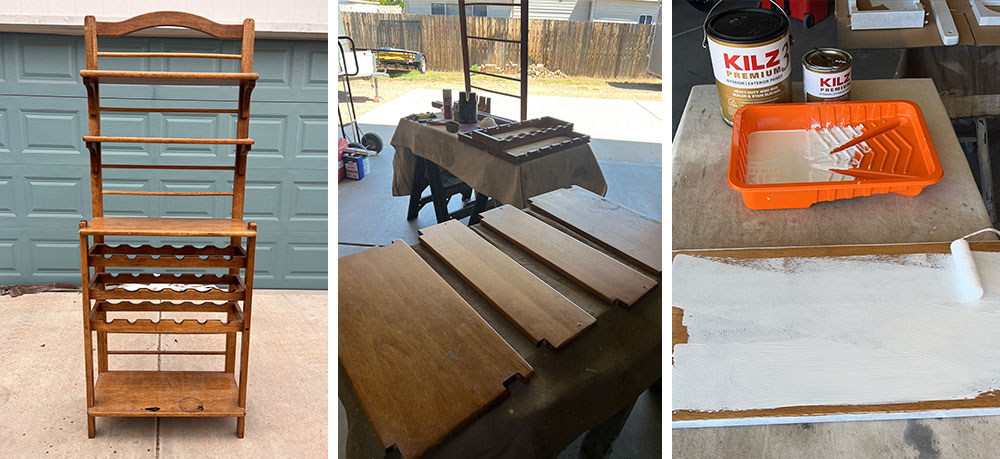
Setting up my workspace was the next step. I used two tables to hold each piece of the wine rack after the disassembling process. With a screw gun in hand, I broke the wine rack down into individual pieces. I then used 220 grit sandpaper to remove the current finish and wiped each piece clean with mineral spirits, preparing them for the first coat of primer. I used a small ½-inch thick roller nap to apply KILZ 3® PREMIUM Primer. After allowing it to dry for only an hour, I lightly sanded all surfaces again and then was able to apply a second coat using the same size roller nap. Due to the mil thickness of the primer, it fills in the wood grain and any small scratches and imperfections in the wood, providing a perfectly smooth surface for paint application.
Since this piece will get used quite often, the superior adhesion provided by KILZ 3® PREMIUM Primer will prevent the topcoat from scratching and chipping, ensuring a longer lifespan. After the surface was properly primed and restored, I allowed it to dry for 24 hours. Once completely dried I used 320 grit sandpaper to smooth down all surfaces in preparation for the topcoat. For this project, I decided to use BEHR PREMIUM™ Spray Paint in Black Satin for the main legs and shelf brackets. Then I used BEHR PREMIUM™ Spray Paint with a Hammered Finish in Dark Bronze on the shelves and wine racks to give the piece more visual interest with a two-toned finish.
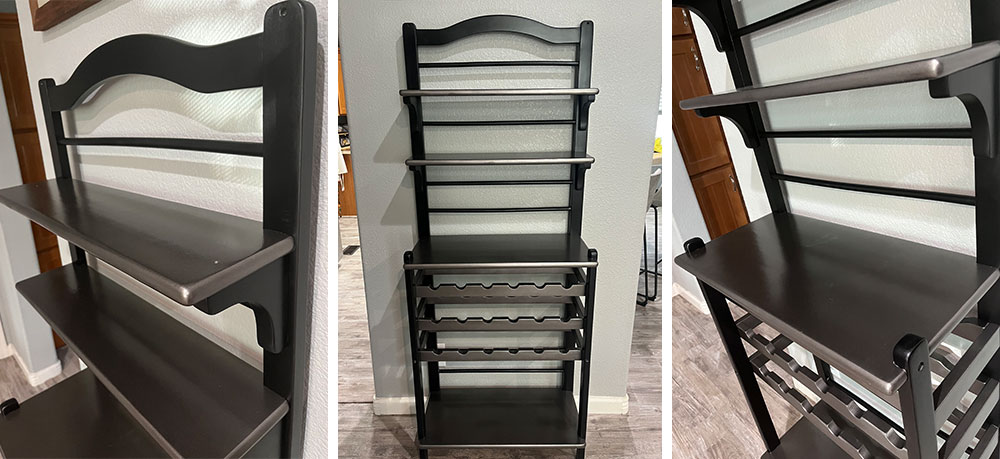
Finally, after another 24 hours of drying time, the rack was ready to be reassembled. It is important to give this additional cure time to make sure the surface is completely dry, and all the products are working together to provide the sleek, durable, and long-lasting finish I hope to get. Taking the time to prepare the surface properly helps save time and money as KILZ 3® PREMIUM Primer offers dependable and consistent results. Placing the piece in the perfect location on the divider wall, I felt I had achieved my desired outcome. It was another job done right with an Instagram-worthy finish, and a piece I can be proud of for years to come.
Thanks for joining me on another project,
James Mansour
The Arizona Painter
To learn more about primer solutions, visit kilz.com.
Always remember to refer to our website kilz.com or product back labels for additional information on which primer is right for your project and detailed instructions on how to apply our products. Check out our Coverage Calculator to understand your estimated paint needs for your upcoming project.
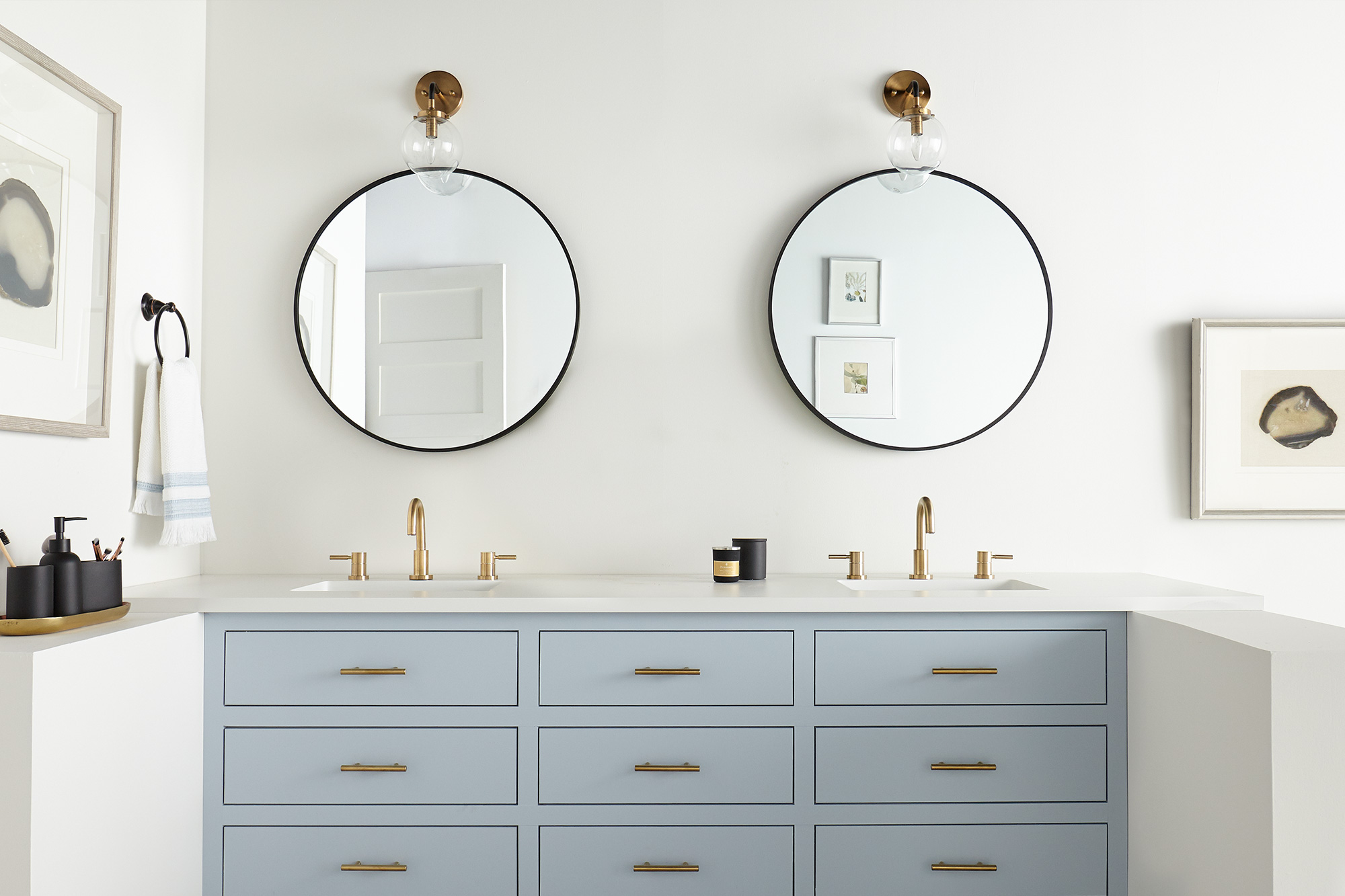
What Are Paint Sheens and What’s the Difference?
June 29, 2023If you’re unfamiliar with the nuances of paint sheen, you’ve come to the right place. In the broadest terms, the higher the sheen a paint has, the higher the shine and the more durable it will be. Flat paint has no shine, while high-gloss paint is all shine, and the rest of the spectrum includes matte, eggshell, satin, and semi-gloss, which can be used for practical and decorative purposes alike.
What’s a Paint Sheen?
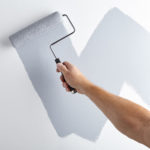 The paint sheen tells you how much light the paint reflects. Paints with higher sheens are shinier, and paints with lower sheens reflect less light. Higher-sheen paints have more enamel in them, which makes them shinier, more durable, and easier to clean. Lower-sheen paints are easier to look at because they have little to no glare.
The paint sheen tells you how much light the paint reflects. Paints with higher sheens are shinier, and paints with lower sheens reflect less light. Higher-sheen paints have more enamel in them, which makes them shinier, more durable, and easier to clean. Lower-sheen paints are easier to look at because they have little to no glare.
Why does it matter?
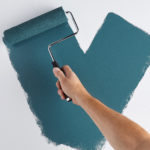 If chosen incorrectly, sheen can amplify surface imperfections, make a surface shinier (or flatter) than intended, or not provide enough durability for the space. Some sheens are easier to clean than others and can provide a barrier against moisture, mildew, and other grime.
If chosen incorrectly, sheen can amplify surface imperfections, make a surface shinier (or flatter) than intended, or not provide enough durability for the space. Some sheens are easier to clean than others and can provide a barrier against moisture, mildew, and other grime.
The darker and richer a paint color is, the more colorant it contains, which boosts sheen. If you’ve chosen a rich or dark paint, and you don’t want it to turn out super shiny, choose one with a lower sheen. In the same vein, if painting a large, sun-washed, or flawed surface, a lower sheen paint is best for hiding imperfections.
What Are the Different Paint Sheen Types?
• High Gloss: A highly reflective, glass-like finish that’s most durable and easiest to clean.
• Semi-Gloss: A sleek and luminous finish that is mildew, moisture, and wear resistant.
• Satin: A pearl-like finish that’s easy to clean and has moderate durability.
• Eggshell: A soft, velvety finish that covers imperfections while offering some durability.
• Matte: A low-luster finish that’s less durable, but easy to clean, touches up well, and hides minor surface imperfections.
• Flat: A non-reflective finish that touches up well and can hide minor surface imperfections.
Where to Use Common Types of Sheen
The type of sheen you choose for a particular room or surface is up to you, and many types can work well for the same area, but you may choose one over another depending on how much traffic the room sees (durability), how prone to dirt or moisture it is, or simply the decorative look you’re going for. Here are some recommendations to help get you started.
• Kitchens: A high or semi-gloss finish in the kitchen ensures your surfaces are more durable and easier to clean.
• Dining Rooms: For moderate-traffic areas like dining rooms, an eggshell finish will provide smooth, clean-looking walls.
• Bedrooms: A flat or matte finish is recommended as these absorb light, which can make those bright mornings more bearable.
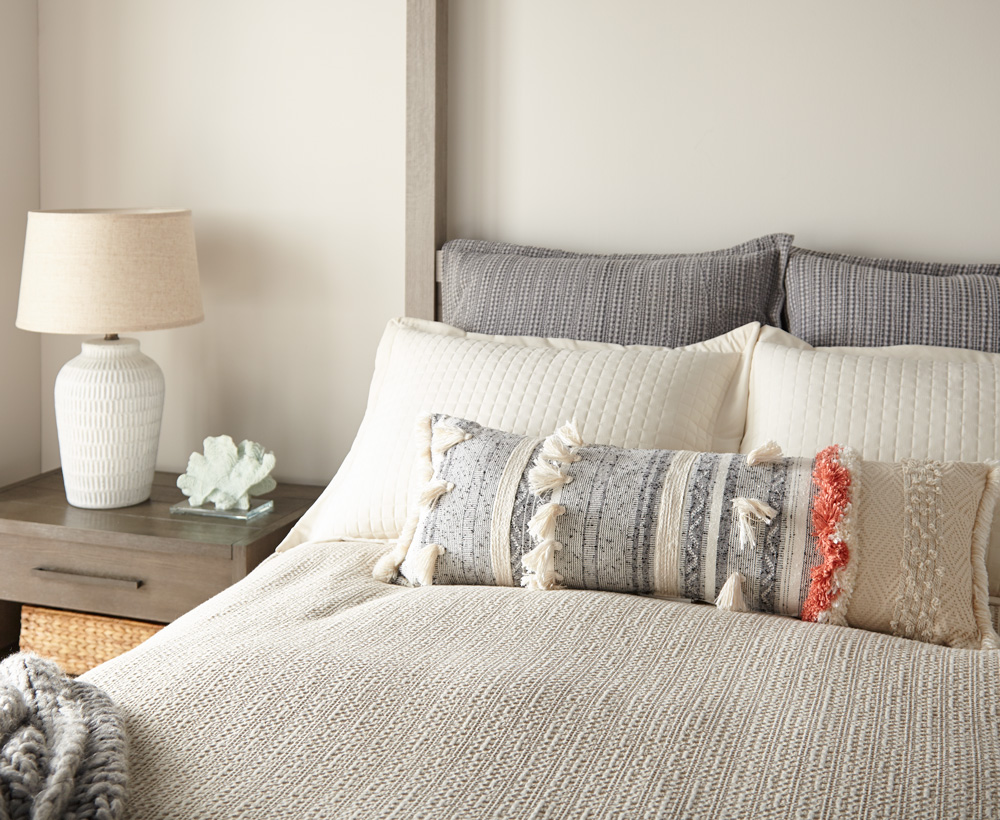
• Bathrooms: Semi-gloss is great at protecting surfaces without being too reflective.
• Living Rooms: A satin finish is your best bet. It’s easy to clean and can stand up to high traffic.
• Hallways: An eggshell finish that’s easy to clean and resists dirt and grime is perfect for these moderate-traffic areas.
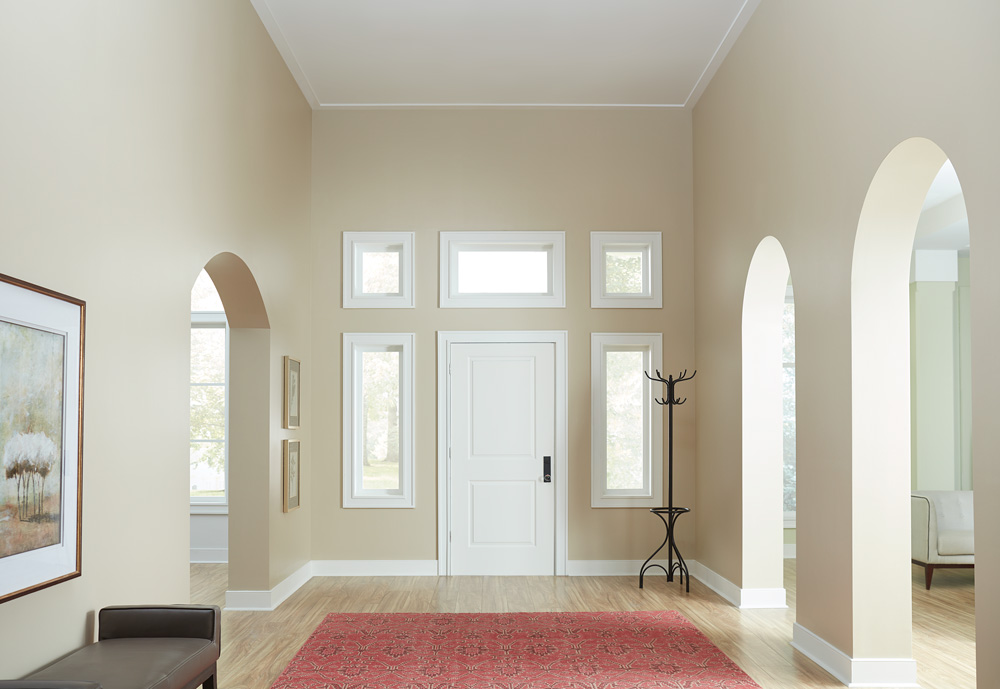
• Ceilings: Ceiling flat sheens are designed for ceilings and are extra splatter resistant.
• Brick/Masonry: Satin or eggshell is perfect for highly textured surfaces like brick; a moderate shine can help to conceal imperfections while giving off a pleasing glow.
• Cabinets: The higher the gloss, the easier it will be to clean and care for your cabinets.
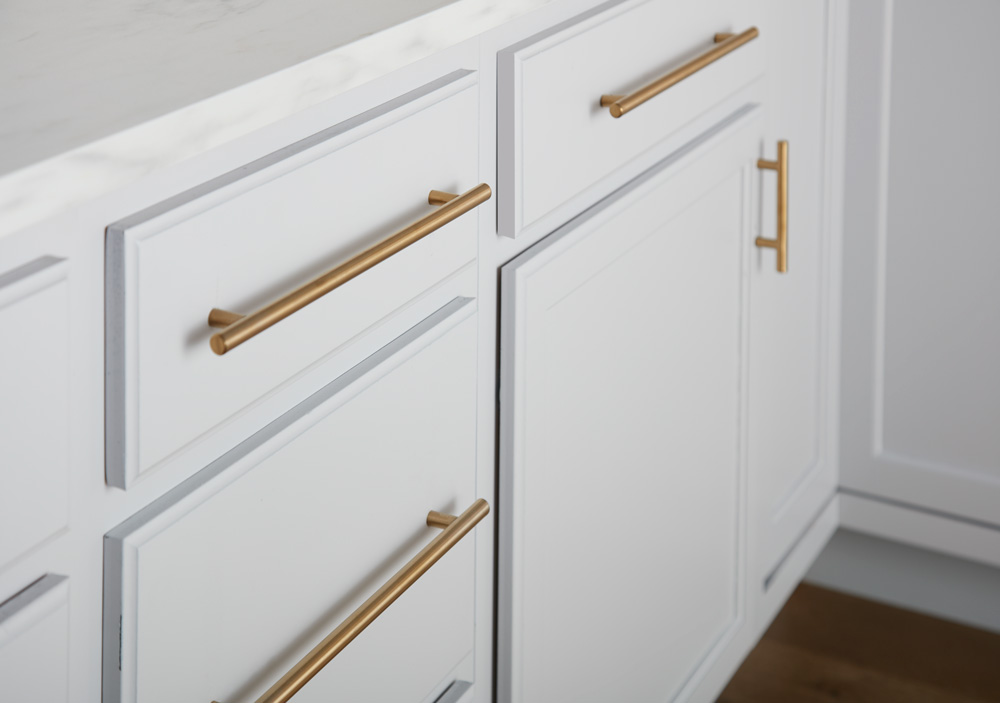
Always Prime Before You Paint
We always recommend using one of our professionally trusted primers to ensure your hard work turns out as beautifully as you intended. Primer provides adhesion for any paint you choose, covers stains, prevents chips, and blocks odors, and helps your topcoat perform its best while achieving the truest possible color. Our primers are made for every project, so choosing the best one for the job is easy.
Always remember to refer to our website kilz.com or product back labels for additional information on which primer is right for your project and detailed instructions on how to apply our products. Check out our Coverage Calculator to understand your estimated paint needs for your upcoming project.
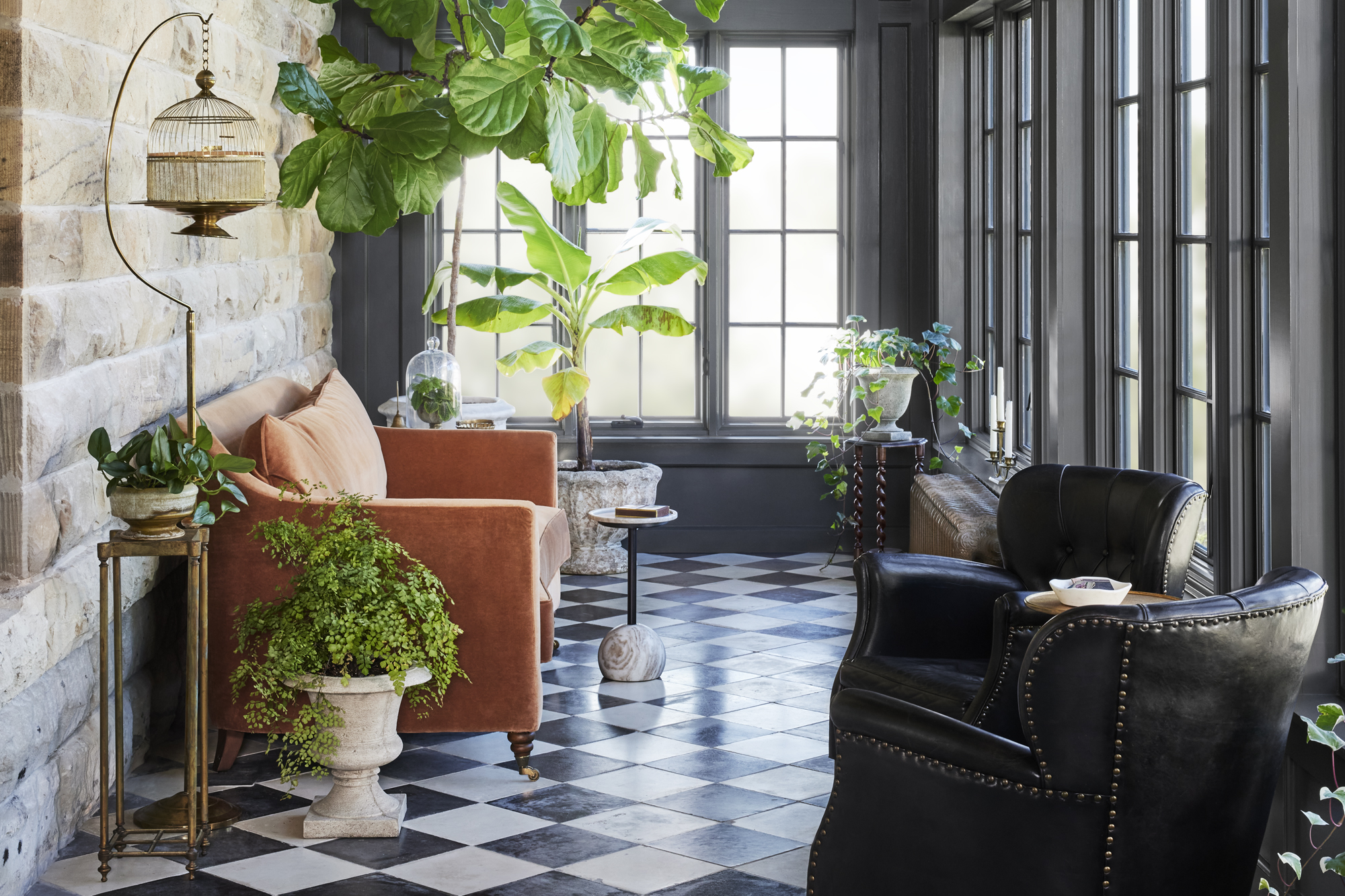

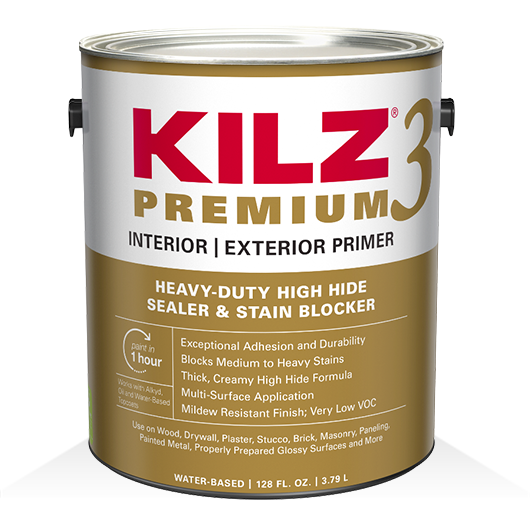
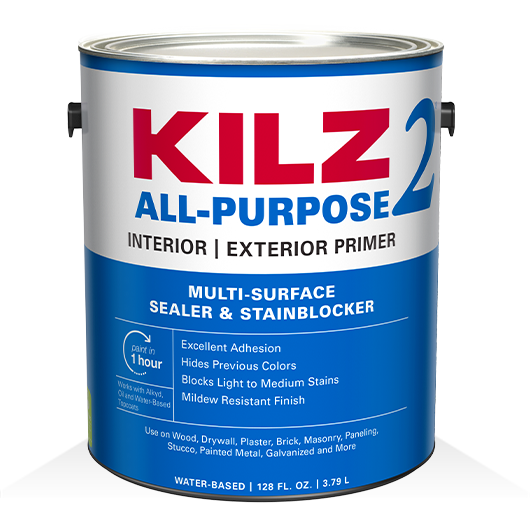
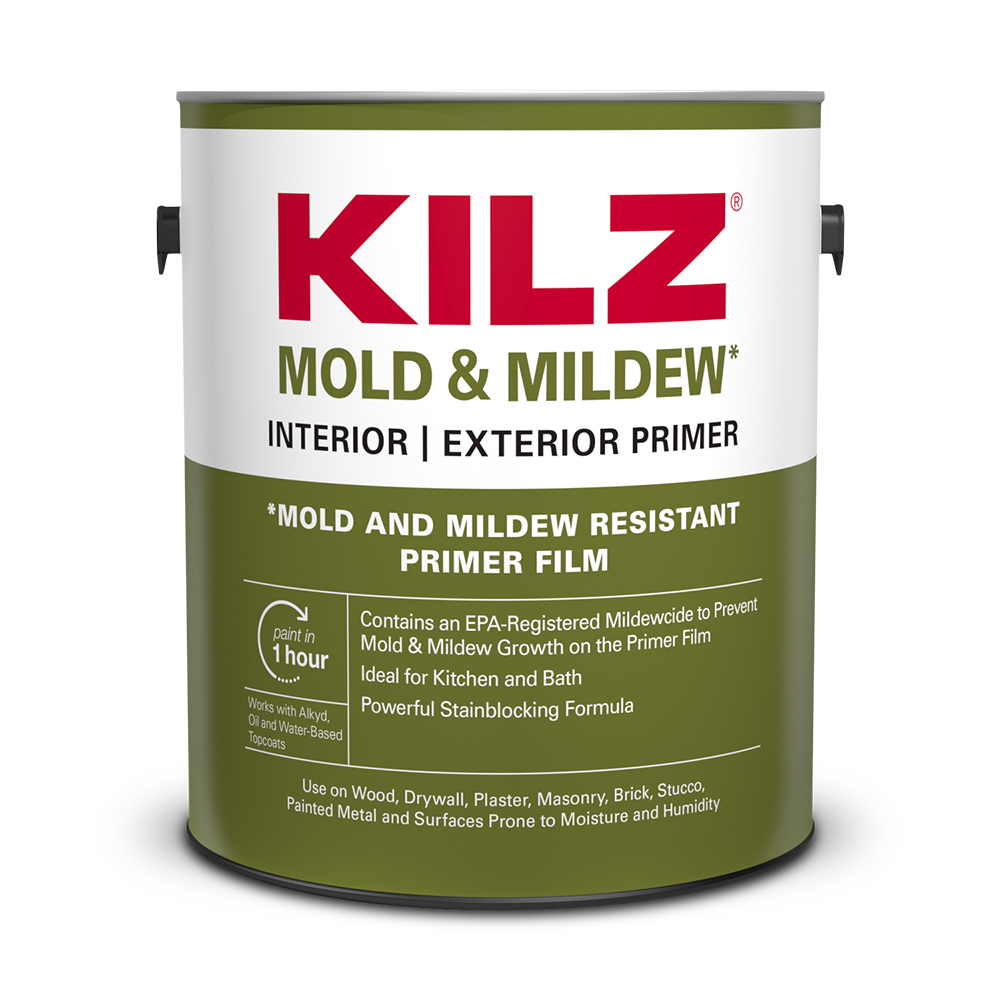
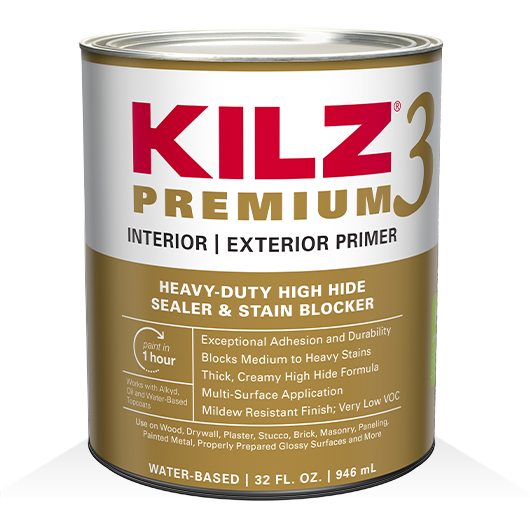
join the conversation:
SHARE this post: